

Wandering Jew
Tradescantia zebrina.
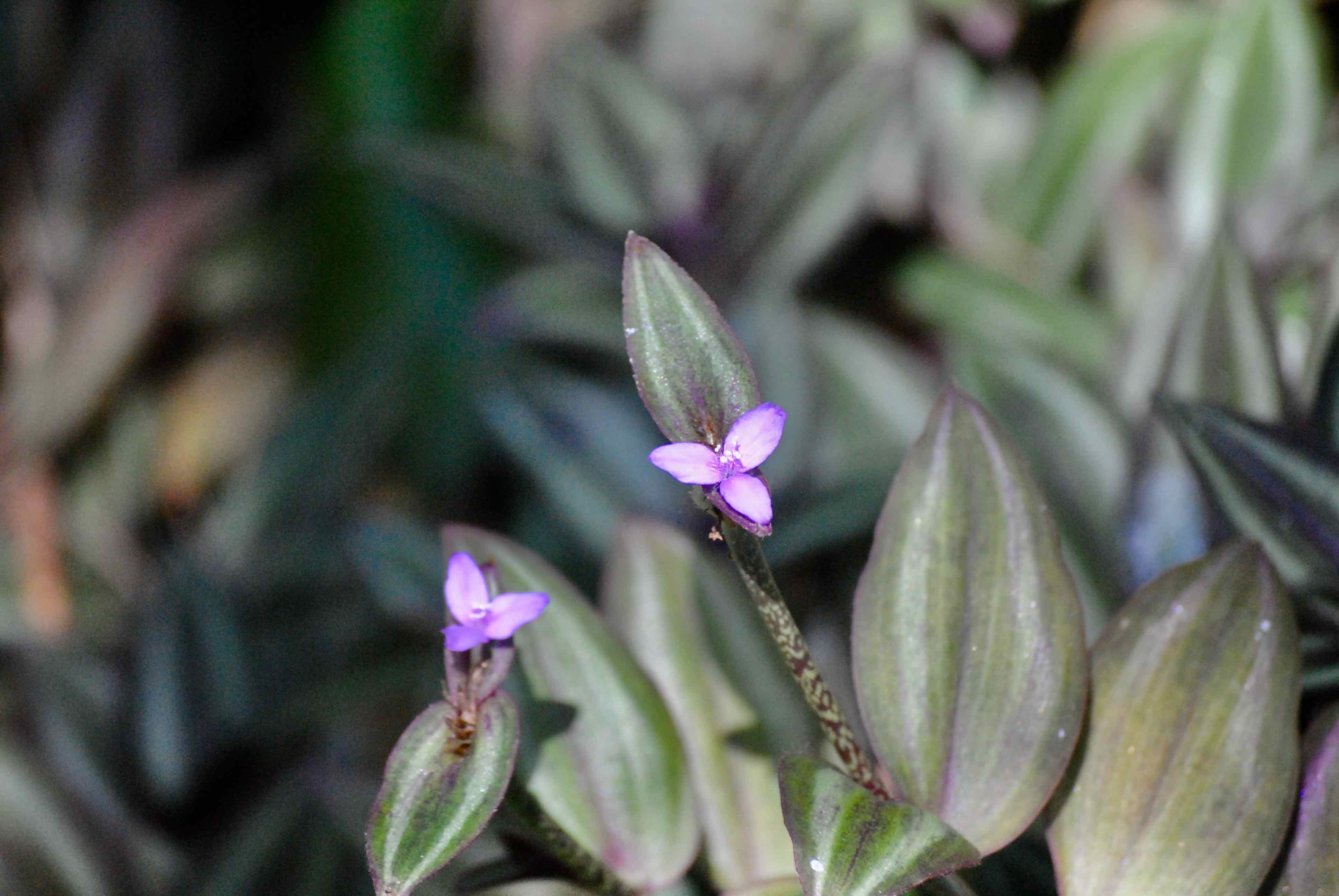
Photographed at Deerfield Island Park, Deerfield Beach, Broward County, in February 2014.
There might not be an easier plant to grow and few that are more attractive than wandering Jew, Tradescantia zebrina . Throw a piece of it on the ground and odds are it will take hold.
Which is one big reason why wandering Jew has become an invasive pest in many parts of the world. An attractive, invasive pest, but an invasive pest nonetheless.
Wandering Jew is a native of Mexico and Central America, including Belize, Honduras, Panama, Costa Rica and Guatamala. It's beauty, however, has taken it to nearly every corner of the globe as a house or garden plant. The problem is it invariably escapes cultivation and establishes itself in the wild. According to the the U.S. Department of Agriculture, it has done so in three states: Florida, Hawaii and, bizarrely, Kentucky. According to the Invasive Species Compendium, it's considered invasive in Hawaii and Kentucky but not Florida. Its range in Florida is pretty much restricted to the southern tip of the Peninsula, excluding Monroe County.
By far, the strangest thing about this plant is the name. According to one source , the name comes from several stories involving a Jewish man who had been cursed to wander the earth until eternity. Some of the stories have anti-semitic roots, some not. The name became attached to our guy apparently because of its tendency to spread , or wander. The name also has been applied to a bird, a card game and a dice game as well as two related plants.
It's also known by one of the least complimentary names we've seen given to any plant: cockroach grass. Don't ask. We don't know.
The plant itself is full of purples and reds and greens, with a tinge of silver. It creeps along the ground, rooting at nodes along the stem. The flowers are bright pink, with three petals. But wandering Jew rarely reproduces by seed. Instead, it spreads vegetatively. It is extremely brittle and pieces can break off as a human or animal, passes through a patch. And each piece potentially is a new plant. Rain water running off a site can carry pieces short distances where they can root and take hold and form new colonies. It also gets spread through improperly dumped yard and garden waste. It can form dense mats and crowd out native plants. It's considered invasive in parts of Asia, including the Philippines, Singapore and Taiwan, in the Canary Islands off the coast of Africa, in Australia, Fiji, Samoa, Tonga, New Guinea, Brazil and Ecuador, the Galapagos in particular, parts of the Caribbean, including St. Lucia, where large mats of wandering Jew have grown along the economically vital Gros Piton Trail , which is a Unesco World Heritage Site.
Other common names: inch plant, silver inch plant, striped trad, striped wandering Jew, striped wandering creeper, wandering zebringa, zebra plant and creeping Jenny. Other spellings include inchplant, inch-plant and wandering-jew. It's a member of Commelinaceae, the day flower family.
Click on photo for larger image
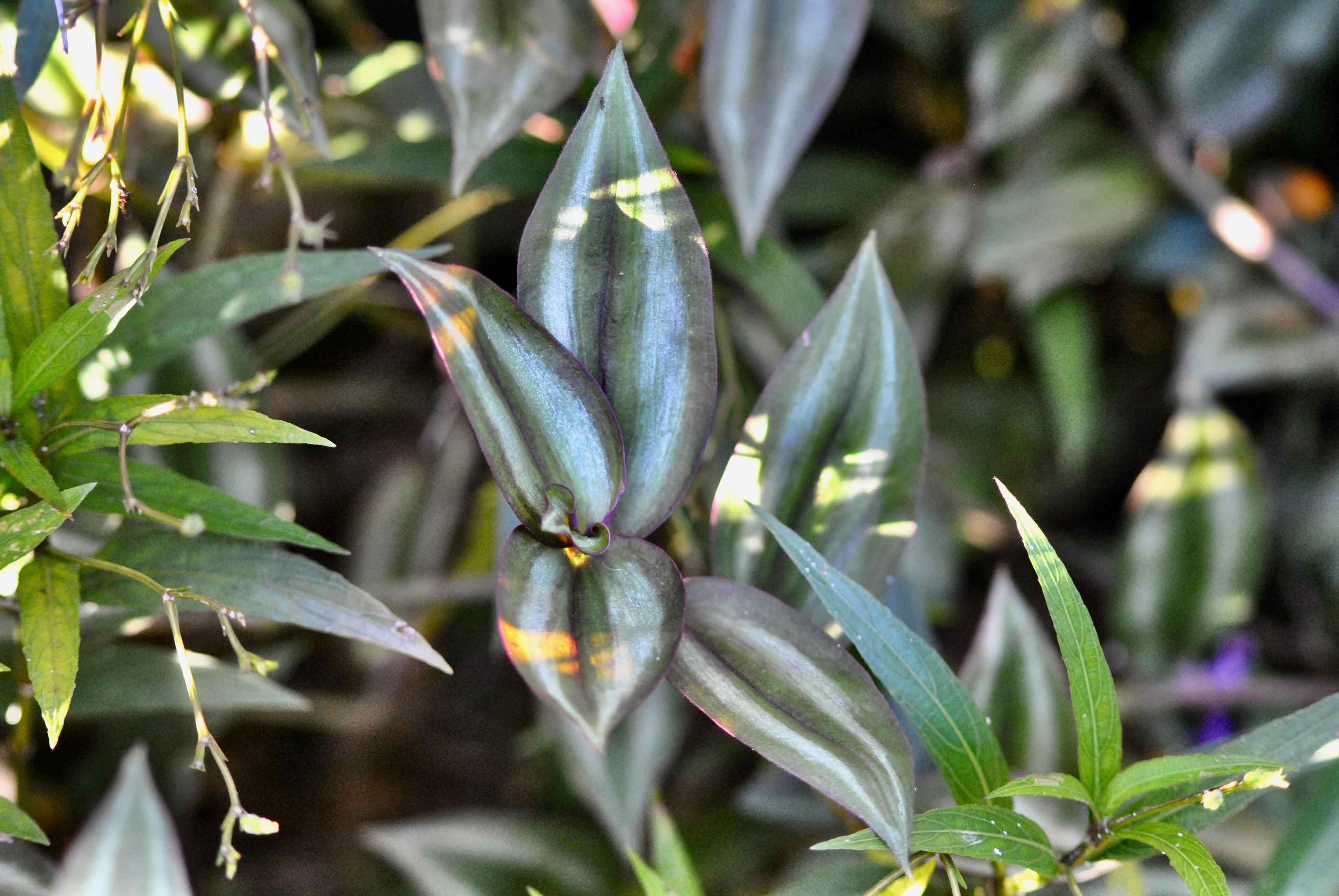
U.S. Department of Agriculture Distribution Maps
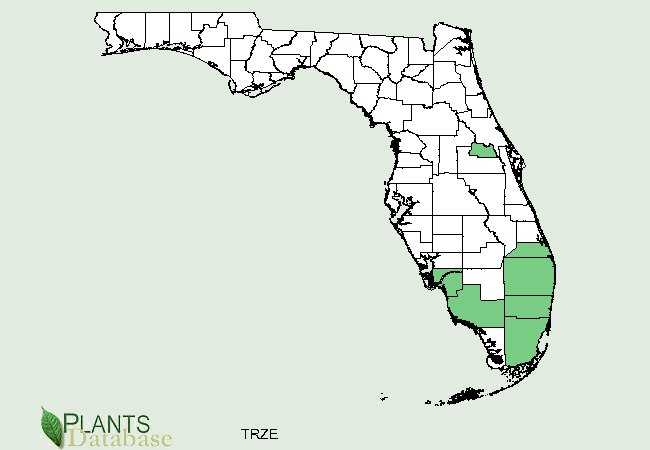
Links for Wandering Jew
- Institute for Regional Conservation
- Atlas of Florida Vascular Plants
- USDA PLANTS Database
- Flora of North America
Published by Wild South Florida, PO Box 7241, Delray Beach, FL 33482.
- Follow Us on Facebook
- Read the Back Country Blog
Photographs by David Sedore. Photographs are property of the publishers and may not be used without permission.
Wandering Jew Plants Guide: How to Grow & Care for “Tradescantia zebrina”
It might surprise you to learn that “the wandering Jew” isn’t a single plant, its name used to describe a collection of plants in the Tradescantia genus.
Many countries around the world view the wandering Jew as an invasive species. Therefore, you won’t find many of them as regular additions to gardens . However, the vine makes for an excellent indoor plant .
Table of Contents
Quick Facts
Wandering jew plant varieties.
The wandering Jew refers to three different plants in the Tradescantia genus. The three varieties are the zebrina, fluminensis, and the pallida.
Tradescantia Zebrina
The zebrina is the most common of the three species, and it features dark-green foliage that contrasts against the brilliant-white three-petal flowers the plant produces.
As you can imagine, the plant also gets part of its name from the zebra-like foliage. The center of the leaf id has a creamy-white color, and the outer trimming of the leaves has a silver lining.
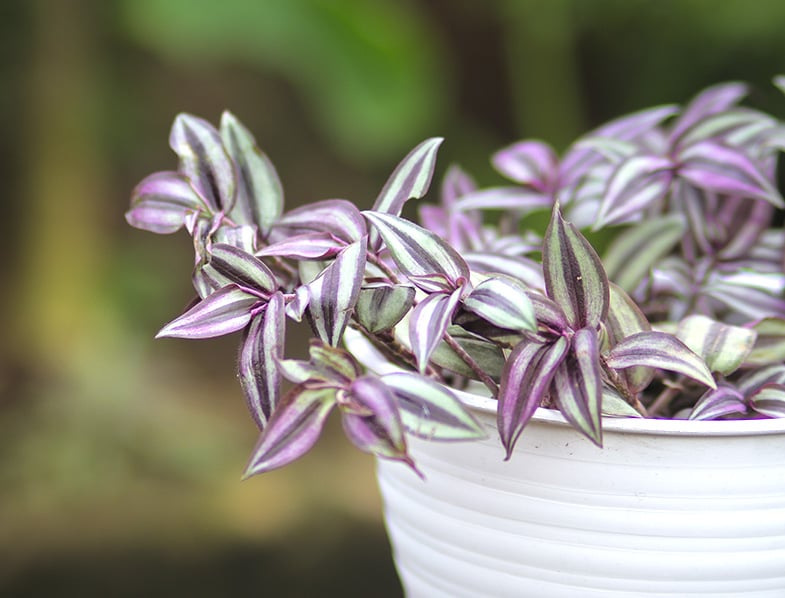
Tradescantia Fluminensis
This wandering Jew species features white flowers, and it’s a trendy indoor plant around the world. The species originates from the southeastern region of Brazil. It’s an evergreen perennial plant that flowers all-year-round and lasts for many years if the owner takes care of it correctly.
The oval-shaped foliage of the Fluminensis is green in color and has a glossy look. The leaves attach to fleshy stems, and the stem nodes quickly put roots down into the soil, allowing for the rapid spread and growth of the plant in ideal growing conditions.
When the plant flowers , it produces a set of flowers with three white petals. The flowers don’t bear any seeds, and they might also emerge in clusters. There are various sub-species of this plant as well, and some types, such as variegate, feature different leaf colors, such as yellow or cream streaks in the leaves.
The plant does best in USDA zones 9 to 12, as it loves the additional humidity in these regions as well. The wandering Jew doesn’t do well in colder climates, so stick to planting in the southern states.
The wandering Jew also prefers full sunlight during the day, and you’ll need to feed it a reasonable amount of water throughout the week. The plant doesn’t enjoy being dry for long periods.
Tradescantia Pallida
This variety originates in Mexico, and it’s the most attractive of the three Tradescantia genus. This wandering Jew produces long, pointy leaves that can reach lengths of 7-inches. The leaf will eventually turn a purple color, but the tips might remain red or green during the color transition.
There are visible segmentations on the stem of this wandering Jew, and it’s for this reason that many countries classify this plant as invasive.
The segments break easily, but they root readily, evolving into two plants with little care. Fortunately, for fans of the plant, it also makes it easy to grow the plants for cuttings as well.
Tradescantia pallida don’t like the cold, and it will die back in colder environments in the Northern states, especially if it grows outside. This wandering Jew produces small flowers that bloom in colors of pink, lavender, and white. The flowers feature three petals, and while they aren’t show-stopping, then do add a beautiful aesthetic to the plant.

- shipped in inproved box to save the plant

Last update on 2024-02-01 / Affiliate links / Images from Amazon Product Advertising API
Natural Air Cleaners
One of the reasons why the wandering Jew is such a popular house plant is its natural air-cleaning properties. The wandering Jew is an excellent “air scrubber,” and it removes bacteria and VOCs from the air inside your home, exchanging it for fresh air that enhances your home.
Some research also shows that the wandering Jew can assist in soil remediation, as well. The plant can remove heavy metals from the soil, helping restore the root health of other plants in the same flowerbed or pot.
Caring for Your Wandering Jew Plant
All varieties of the wandering Jew are easy to care for, provided that you grow them in the right climate and conditions. As long as the plant receives regular watering and pruning, it will thrive, and you’ll also manage to control the growth as well.
If you plant in a sunny spot in your home, then you can expect your tradescantia to last for many seasons. It’s also important to note that the plant might not flower it in its first season. However, by the third year, you should see plenty of flowers that emerge in the summer months.

As mentioned, the wandering Jew prefers sunny planting locations. The plant prefers later afternoon sun to morning sun, but it does well in any sunny area around the home. The more light you give the plant, the more flowers it produces in the flowering season.
If your wandering Jew does not get sufficient sunlight, you’ll notice that the color of the leaves starts to fade. Move the plant to a sunny spot, and it should recover in less than a week.
The wandering Jew enjoys a balanced moisture level in its soil . Don’t let the earth get too dry, as it might cause burning in the tips of the leaves. Likewise, the wandering Jew does not enjoy excessively wet soil either. The plant is susceptible to forming root rot if you “keep its feet wet.”
To check if it’s time to water your wandering Jew, push your finger about 1-inch into the soil. If it feels dry, then give your plant some water.
You must ensure you use a rich, loamy soil that drains well when planting your wandering Jew. When planting in a pot, make sure you add a layer of gravel at the bottom of the pot to enhance drainage. Add perlite to the soil to assist with drainage as well.
You can get away with using a standard potting mix when planting indoors , and other soil enhancements we recommend you add are the following.
- Coarse sand and perlite for drainage
- Humus or peat
- A light dusting of lime
- A few handfuls of rich organic compost
You want the soil to retain water but still allow optimal drainage.
During the growing season, fertilize your wandering Jew plant using a liquid-based fertilizer product. Make sure that you dilute the fertilizer to 50-percent strength.
Strong concentrations can result in burning in the tips of the leaves of the plant. You can also add a granular slow-release fertilizer to the soil once a year at the start of spring.
The wandering Jew grows quickly, and it might take over its pot in one or two seasons, depending on the size of the container. Therefore, you’ll need to pull up the plant and divide it from year-to-year, depending on its growth rate.
If you choose to re-pot your plant, make sure you use a pot that’s at least 50-percent larger than the old one. Line the pot with potting soil and a few handfuls of rich organic compost. Dig around the edges of the existing container to loosen the root ball. After loosening, pull the base of the plant to release it from the pot.
Move the plant to its new pot, and then fill with potting mix to cover the roots — Pat down the soil, and then water lightly.
Wandering Jew plants require regular pruning . The plant grows quickly, and if you don’t prune, then it can overtake the pot fast. Pruning also helps the stem, from getting “leggy,” meaning that the plant starts to look bare at the base. Pruning keeps the plant healthy and growing at an optimal rate.
All; you need to do is prune back any stems and pinch the stem tips. The wandering Jew will then send out two new shoots from the pinched top, helping your plant spread out into a bush-like appearance.
Propagation
The wandering Jew is easy to propagate . This plant grows quickly in a variety of conditions, which is one of the reasons why most countries list it as invasive. You can propagate your cuttings after your pruning session, without much effort.
Remove all of the leaves but the top set after pruning the stem. Place the cutting in another smaller pot with moist potting soil . Leave the container in the sun, and you should find that the cutting roots in a month.
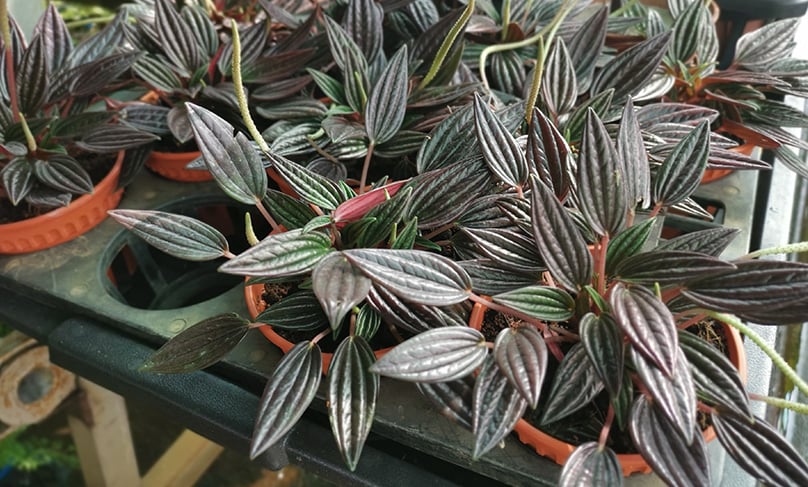
Being an indoor plant , the wandering Jew does not get much attention from pests. However, spider mites can be a problem for your plant if you don’t take care of it and watch for the presence of pests.
Spider mites are tiny spider-like bugs that form a web around the inside of the leaves of the plant. If left unmanaged and untreated, they might start to cause yellow spots in the foliage. The wandering Jew might also fail to flower in the summer months as well.
Over-watering your wandering Jew plant can result in the onset of diseases like root rot. Ensure that you have a well-draining soil mix before planting your wandering Jew. Provided that you do everything you can to ensure your soil drains well, you should never have a problem with root rot in your wandering Jew plant.
Wandering Jew Plants FAQS
What is the best way to grow a wandering jew plant.
The best way to grow a Wandering Jew plant involves placing it in a location that gets plenty of sunlight, preferably late afternoon sun. You should use well-draining, loamy soil to plant it, and ensure a balanced moisture level by watering it regularly but not excessively. The plant also appreciates humidity and occasional fertilizing with a liquid-based fertilizer diluted to 50% strength during the growing season. Pruning should be done regularly to manage its growth.
Is Wandering Jew easy to grow?
A: Yes, Wandering Jew plants are generally easy to grow. They adapt well to various conditions and are fast-growing. They can be propagated easily from cuttings and require minimal maintenance beyond regular watering, pruning, and an occasional application of fertilizer. However, they do not tolerate cold climates very well.
Does wandering Jew like full sun or shade?
Wandering Jew plants prefer locations with full sunlight. They can tolerate some shade but too much shade can cause the color of the leaves to fade. More sunlight exposure generally leads to more flowers during the flowering season.
How often do you water Wandering Jew?
Wandering Jew plants should be watered regularly to maintain a balanced moisture level in the soil. However, the soil should not be allowed to become too dry or too wet. Overwatering can lead to root rot. A good way to check if it’s time to water is to push your finger about 1-inch into the soil. If it feels dry, it’s time to water the plant.
Is Tradescantia Zebrina easy to grow?
Yes, Tradescantia Zebrina, a variety of Wandering Jew, is easy to grow. It requires similar care to other Wandering Jew varieties and is known for its adaptability and quick growth.
Does Tradescantia Zebrina need full sun?
Tradescantia Zebrina does best in a location with full sunlight. While it can tolerate some shade, insufficient sunlight can cause the leaves to lose their vibrant color. Like other Wandering Jew plants, the more light it gets, the more flowers it produces during its flowering season.

Hollie is a life-long gardener, having started helping her Dad work on their yard when she was just 5. Since then she has gone on to develop a passion for growing vegetables & fruit in her garden. She has an affinity with nature and loves to share her knowledge gained over a lifetime with readers online. Hollie has written for a number of publications and is now the resident garden blogger here at GardenBeast. Contact her at [email protected] or follow on twitter https://twitter.com/greenholliec
Pampas Grass Guide: How to Plant & Care for “Cortaderia Selloana”
Rhaphidophora tetrasperma guide: how to grow & care for “mini monstera”, corn plant guide: how to grow & care for “dracaena fragrans”.
under the photo “easy to propagate”, that is not a wandering jew-its a peperomia “rosso!”
My wandering jew plants leafs are getting dried. Why is that?
It’s not getting enough humidity
Could you elaborate on “rich organic compost”? What should it be made of, exactly? Can I use compost accelerator in the soil mix?
Worm castings are great, or worm tea, egg shell tea is another.
What month does the jew break ground to start growing?
All depends on your specific areas weather pattern and seasons.
Do NOT BUY ANY OF THIS SPECIES if you have a dog because dogs are very allergic to these plants & come out in bad rashes if they wander through them!
Leave A Reply Cancel Reply
Save my name, email, and website in this browser for the next time I comment.
Type above and press Enter to search. Press Esc to cancel.
- Privacy Policy

- Houseplants
- Gardening And Landscaping
Wandering Jew Plant (Tradescantia or Spiderwort): Care, Types, Images and More
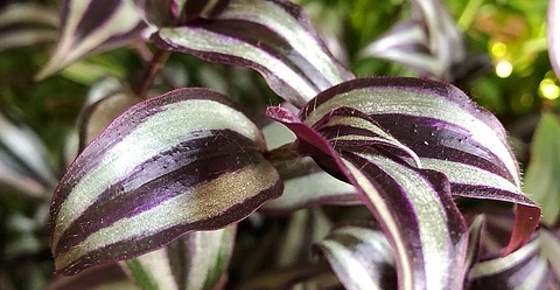
The wandering Jew plant is a common name for different species of plants that belong to the Tradescantia genus. There are around 75 different types of plants in Tradescantia genus and some are called inch plants, spiderwort, striped wandering Jew, Boat Lily, Purple Queen, or flowering inch plant. Wandering Jew plants are great house plants because they are relatively easy to care for. They are also easy to grow because the wandering Jew plant propagates easily from cuttings.
Some types of wandering Jew plants have green and gold leaves, some have reddish leaves, and others have green fuzzy leaves. There are also types of wandering Jew plants that flower. Depending on the species, the wandering Jew plant could have purple, white, or pink flowers.
How to care for wandering Jew plant : For the Tradescantia or spiderwort plant to thrive, grow in a plenty of indirect light and plant in fertile, moist potting soil with good drainage. Make sure the soil isn’t too dry or too damp and keep medium humidity levels. The ideal temperature range is between 65°F (18°C) and 75°F (23°C). You can fertilize every four weeks during the growing season with a diluted liquid houseplant fertilizer.
In this article, you will find all you need to know about this delightful houseplant. You will also get tips and ideas on how to care for your wandering Jew plants.
Wandering Jew Plant (Tradescantia or Spiderwort) – Overview of the Plant and Its Flowers
The botanical name for wandering Jew plant is Tradescantia zebrina and is also called the inch plant. However, the name wandering Jew is given to many herbaceous perennial plants in the Tradescantia genus. ( 1 )
Species of Tradescantias naturally grow outdoors in countries in Asia, Africa, Central and South America, and Australia. Varieties of wandering Jew plants also thrive well indoors, where, like their garden varieties, they grow well when it is warm, sunny, and moderately humid.
According to the United States Department of Agriculture, various varieties of Tradescantias are regarded as invasive plants in the wild. However, it is the fast-growing nature of spiderworts, wandering Jews, and inch plants that makes them perfect houseplants. ( 2 )
Many people like to grow wandering Jews or spiderworts in hanging baskets or grow them in pots to decorate a garden.
What does a wandering Jew look like?
Plants from the Tradescantia varieties have leaves that seem to grow in all directions (hence the term “wandering Jew”).
One of the distinct features about foliage on wandering Jews is that many of them have striped leaves. Sometimes, the leaves can be purple and silver stripes, whereas other types of Tradescantias have leaves that are almost all silver. ( 3 )
You may also notice that some varieties of wandering Jew plant have different colors on the underneath of the leaf. For example, the Tradescantia zebrina has green/silver leaves on the upper side and deep red or burgundy colors on the underside.
Wandering Jew flower
Wandering Jew houseplants also produce attractive flowers. These flowers can sometimes be white or can range in color from pink to various shades of lilac and purple. ( 3 )
However, plant lovers don’t usually grow wandering Jews indoors or outdoors for their blooms. It’s the beautiful variation of leaf colors that makes various types of Tradescantias so desirable houseplants.
Types of Wandering Jew (Spiderwort) Plants
The most popular types of Tradescantia plants to keep indoors are Tradescantia fluminensis ( spiderwort ), Tradescantia pallida ( purple heart ), and Tradescantia zebrina ( wandering Jew ).
Wandering Jew or inch plant ( Tradescantia zebrina )
This type of wandering Jew houseplant has purple and green leaves with a stripe pattern that resembles zebra’s stripes. There are types of wandering Jews that have bluish green leaves and purple hues on the underside.
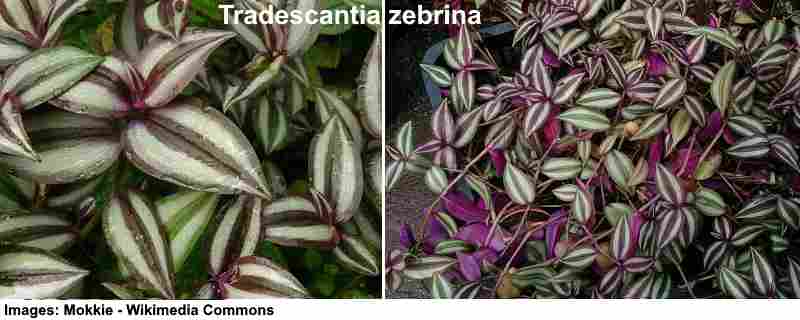
Tradescantia fluminensis (spiderwort)
There are a number of types of Tradescantia that are called spiderwort. This is distinguished from some Tradescantias as it has ovel shiny dark green leaves with pointed tips which are slightly fleshy .
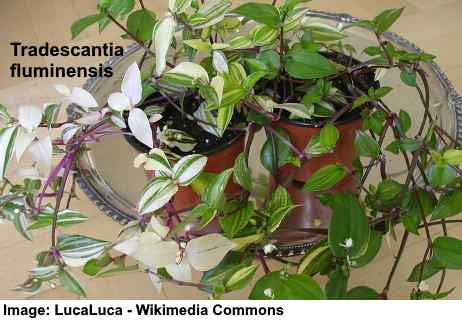
Picture of wandering Jew plant with white flowers
Tradescantia pallida (purple heart)
This type of spiderwort plant is also commonly referred to as wandering Jew. The T. pallida houseplants have vibrant purple leaves and light pink flowers when they bloom.
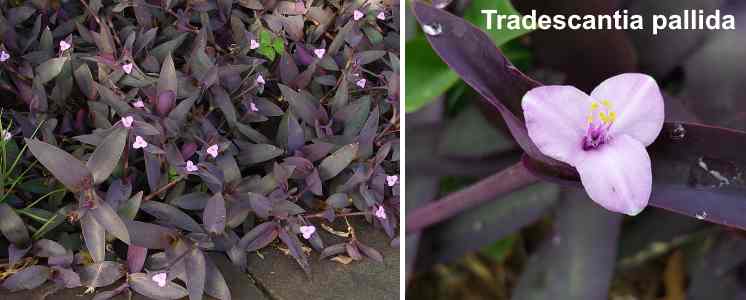
Wandering jew plant with deep purple leaves and light purplish-pink flowers
Tradescantia callisia
The leaves of T. callisia varieties are sometimes referred to as creeping inch plants. They have remarkably stripy leaves made up of green and white stripes.
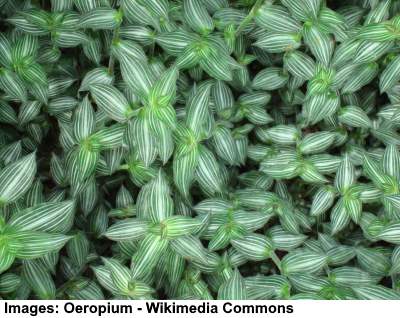
Picture of green wandering jew
Wandering Jew Plant Care (How to Grow Spiderwort or Tradescantia)
Caring for wandering Jew plants is fairly simple and straightforward. All plants in the Tradescantia genus enjoy moist soil, sunny but indirect sunlight, and warm conditions.
So, it doesn’t matter if you have fuzzy leaf Tradescantias, purple queen varieties, spiderworts, or wandering Jews, they all require the same type of care.
Light requirements for Tradescantias
To make sure that wandering Jew plants grow successfully, they require a good amount of light. This ensures that they grow with healthy leaves that have a vibrant green, silver, purple, or lilac colors.
The best place to place wandering Jew plant or spiderworts is in an east- or west-facing location. This means that they get plenty of natural light without being in direct sunlight when the sun is at its strongest.
The only exception is if you have Tradescantia pallida plants with dark purples leaves. They usually thrive in direct sunlight, although you should regularly check them in the summertime to make sure the sun isn’t too strong.
One sign that your Tradescantia isn’t getting enough light is if the color of their leaves starts to fade.
Best growing temperature for Spiderwort or Tradescantia
One of the reasons why wandering Jew plants are good for the home is that they thrive in room temperature.
The best temperatures for growing any type of Tradescantia plant is between 65°F (18°C) and 75°F (23°C). The houseplants also thrive in conditions that are described as “average humidity.”
If you grow Tradescantias outdoors, you should be aware of a drop in night temperatures and lower temperatures during winter. You should bring Tradescantias indoors if the temperature drops.
Best watering techniques for wandering Jew plant care
To care for your inch plant, spiderwort, or wandering Jew, you should keep the soil moist.
The best way to water a wandering Jew is to water the soil thoroughly and let the water drain out the bottom. Another way to water your purple house plant is to put water in the plant pot tray and allow the plant to soak up as much as it needs.
Some beginners who start caring for houseplants such as Tradescantias for the first time buy a soil moisture gauge to help get the soil moisture levels just right.
When it comes to proper watering for your wandering Jew, always make sure the soil isn’t too dry or too damp. Usually, weekly watering in the summertime is enough to keep your Tradescantia growing well.
The best fertilizer for wandering Jew houseplants
The reason why Tradescantias are so easy to care for is that they don’t usually require any feeding.
If you decide to encourage your inch plant or spiderwort to grow faster, then choose a liquid organic fertilizer mixed at half strength and use once a month.
Most houseplant growers don’t feed their wandering Jew plants in the fall or winter as they tend to become “leggy” or “straggly.”
Which type of soil to use for Tradescantias
To properly care for wandering Jew varieties of houseplants, you only need to plant them in regular potting soil.
How to prune wandering Jew plants
In time, Tradescantia plants require some cutting back and pruning. This helps to give your houseplant a bushier appearance and also gives you plenty of cuttings to propagate.
For Tradescantia pruning, you just need to pinch off the stem tips to leave about ¾ of the length. This will encourage your plant to grow better and become more attractive.
Growing Plants from Wandering Jew Cuttings
Even for the most novice of houseplant owners, propagating any type of Tradescantia plant is very easy. After you have cut back your “leggy” wandering Jew stems, you will have a large number of cuttings that you can use to grow new house plants.
How to propagate wandering Jew plant leaves
To prepare your wandering Jew cuttings or purple heart plant cuttings for propagation, you need a couple of stems about 1-2 inches long. Remove all the leaves apart from 2 or 3 at the end of the stem.
There are 2 ways you can grow wandering Jew plants from cutting:
- The first way is to just put a cutting in potting soil and wait for it to grow. All you have to do is make sure that the soil is kept moist and not overly damp.
- The other way to grow a Tradescantia from a cutting is to put the stem in water. You should notice that new roots start to grow within a week. When you notice new roots growing, you can transfer your cuttings to a pot to grow a new houseplant.
Wandering Jew Outdoor Plant Care
Tradescantia plants are great garden plants and grow well outdoors in warmer zones in the U.S. (USDA growing zones 9-11). In fact, it is because they grow so well outside in warmer countries and are quite invasive that they are classed as a weed in certain countries.
You can easily care for any Tradescantia plants to add color and beauty to your garden. Purple hanging plants or wandering Jew vines with stripy leaves can grace any patio, doorway, or garden area.
As with caring for wandering Jews or spiderworts indoors, Tradescantia plants growing outdoor should be protected from direct sunlight. So, place your plants in shady areas of the garden. But it’s good to remember that some bright light will help the wandering Jew plant produce more flowers.
Temperature
Also, frost can damage the plant, so, if you live in areas where fall and winter temperatures drop below 10°F (12°C), you should take them indoor and continue to grow them as houseplants.
Problems with Wandering Jew Plant (Spiderwort)
Even though it is relatively easy to care for wandering Jew plants, you can still come across certain problems.
Let’s look at some growing tips for Tradescantia plants to avoid or remedy some common problems.
The most common pest when growing wandering Jews indoors are bugs such as spider mites or aphids . The appearance of these pests on your bushy spiderwort or inch plant may be a sign that conditions are too dry.
To help remedy the problems of pests on your Tradescantia, mist the leaves regularly and make sure the soil is moist enough. You may need to wash off the mites with water to help get rid of the infestation.
One of the beauties about caring for wandering Jew plants indoors or outdoors is that they are not susceptible to disease. Usually, any discoloration of the leaves or poor growth is connected to the soil being too dry or too damp.
Fungal infections
Overwatering spiderworts, inch plants, or wandering Jews can cause a fungal growth called botrytis to develop in the roots.
Brown leaves
As with most problems associated with caring for Tradescantias, brown leaves can also indicate that the growing environment isn’t right. The leaves of your wandering Jew could have turned brown because of too much or too little sunlight. Also, too much watering can affect leaf health.
Where to Buy Wandering Jew Plants
Many garden centers and online stores stock many different varieties of wandering Jews. You will also find that Tradescantia cuttings are available online.
Because many different types of wandering Jews are so easy to grow yourself, you could ask a friend for a cutting if they have the plant. You can also get more Tradescantia houseplant or garden plants by propagating cuttings from plants you already have.
FAQ Related to Wandering Jew Plant (Tradescantia)
Do they need any pruning.
To properly care for wandering Jews, the leaves and stems require pruning. The stems can grow quite long and start losing their leaves from the base. The best time to prune any Tradescantia plant is just before the growing season in late winter or early spring.
You may also find that Tradescantias grow better if you give them a mild prune in late summer.
How to prevent wandering Jew roots from rotting?
Go easy on the watering to stop Tradescantia plants’ roots from rotting. Water them enough to keep the soil moist during summertime and only occasionally in the winter.
Are wandering Jew plant leaves toxic to animals?
While not toxic to cats or dogs, the leaves of wandering Jew plants can cause irritation. If you have pets that like to nibble on leaves, you can still benefit from the beauty of Tradescantias if you grow the outdoor plant in hanging baskets.
Can I grow my Tradescantia plant outdoors?
Yes, you certainly can. Wandering Jew plants grow well out of doors in warm climates. During the summertime, you can move your indoor houseplants to the garden and place them away from direct sunlight.
Dashes of purple colors, bright pinks, or interesting green and purple stripped leaves can make an interesting feature in any garden or balcony.
Can you train a wandering Jew plant?
Tradescantia plants are easy to train because their stems can grow very long and you can wrap them around objects. Wandering Jew plant stems can grow up on trellises or obelisks or up around any other item.
Heavily pruning wandering Jews in late winter can also help to train the plant to grow into a colorful bush.
How fast does wandering Jew plant grow?
Tradescantia cuttings should start growing roots within a week or so. Once the plant is established, you can expect it to grow about an inch every week. Some people claim this is the reason that some Tradescantias are called inch plants.
Can Tradescantia houseplants cause allergies?
The sap of wandering Jew plants or prolonged skin exposure to its leaves could cause allergic reactions.
The journal Allergy reports that indoor plants such as Tradescantia can also cause symptoms such as itching of the throat, swelling, wheezing, and runny eyes and nose. ( 4 )
Do wandering Jew varieties have any health benefits?
Although not widely used, extracts from Tradescantia zebrina have certain medicinal properties. You can buy inch plant herbal liquid extracts that are said to have many antioxidant properties.
Researchers have found that therapeutic compounds in Tradescantia extracts have antibacterial, anticancer, and antioxidant uses. ( 5 )
Related articles:
- Moses In Cradle Care: How to Grow Tradescantia spathacea
- Chinese Money Plant Care: How to Grow Pilea Peperomioides
- Dracaena Marginata Plant Care: How to Grow Madagascar Dragon Tree

Wandering Jew Plant (Tradescantia zebrina): Types, How to Grow and Care
Sharing is caring!
Plants with trailing and creeping habits are some of the best plants to keep. They are fast-growing and make thick carpet of groundcovers for gardens in no time and they also create striking hanging indoor plants.
Among the all-time best trailers to grow is the wandering jew. Easy to maintain and drapes beautifully, this colored plant will make any space more inviting and interesting.
Medicinal Properties
Propagation and maintenance, what is a wandering jew plant.
Tradescantia is one of the 37 genera under the plant family Commelinaceae (1). Some of its 75 species are commonly called ‘wandering jew’ (also known as inch plant), a name they adapted due to their long lifespan like the Jewish character from a Christian folklore.
Another name for this group of herbaceous perennial plants is ‘spiderwort’ after the spiderweb-like sap they produce when the stem breaks. They are native to Canada, Mexico, and Argentina and have been naturalized in other parts of the world (2).
The most common tradescantia grown ornamentally is the T. zebrina also previously called Zebrina pendula . It has long fleshy stems where the wandering jew plant leaves and roots appear. The lance-like leaves are a mixture of green and purple with silver stripes on the upper side and deep purple under (3). The plant grows close to the ground and can only reach 20 to 30 cm high.
Does Tradescantia Zebrina Flower?
The wandering jew is considered an ornamental plant primarily because of its showy colorful foliage but the plant does produce pink flowers.
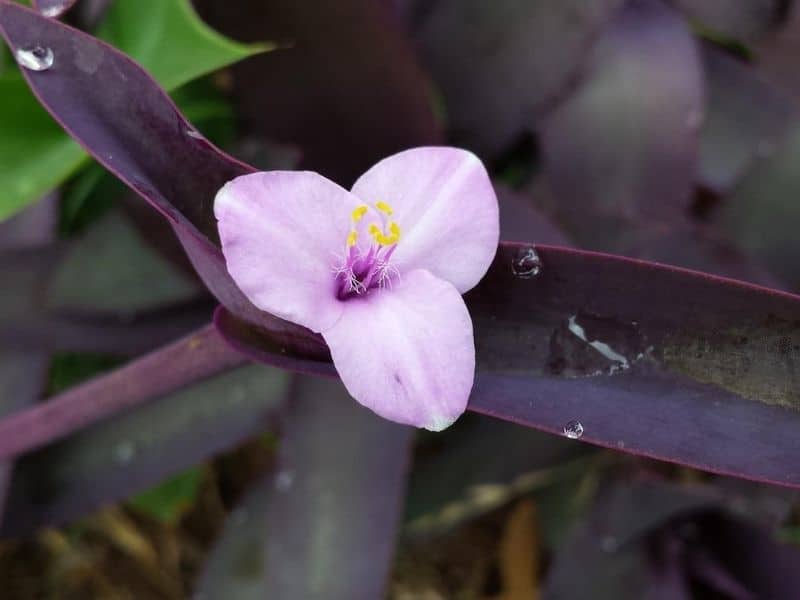
Small three-petaled pinkish purple flowers appear sporadically throughout the year (4). The resulting fruit is a capsule containing tiny brown seeds.
Is it Toxic to Pets?
Spiderworts are normally harmless plants but they contain toxic properties that may cause mild gastric problems and dermatitis to pets. Although they don’t lead to anything serious, it will be safe to keep the plants out of reach of pets and to keep the hands protected when dealing with the sap of the plant.
Because of the plant’s hardiness and adaptability to different environments, the wandering jew establishes well, in fact so well that it can be considered an invasive species. In countries like Australia, the plant has the capacity to invade natural vegetation. Although growing them is not prohibited, everyone is obliged to keep the plant’s growth under control (5).
Studies showed that Tradescantia has significant effects as an anticancer, antioxidant, and antibacterial medicinal plant. In traditional Chinese medicine, the wandering jew plant is highly valued as treatment for kidney failure.
The extract from the whole plant is cooked with dates, ginger, and water and consumed by patients. The plant is also known to treat high blood pressure, cough, urinary tract infection and tuberculosis (1).
How to Grow and Care for a Tradescantia
Here’s how to care for a wandering jew plant, one of the easy house plants to own.
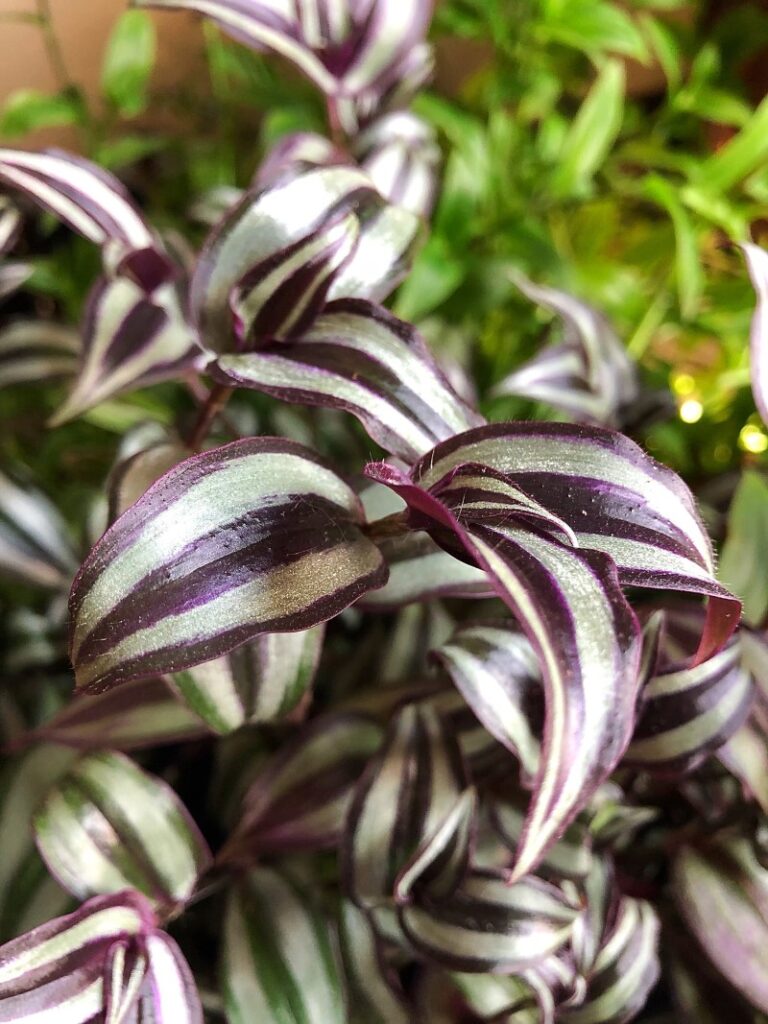
Light and Water
In the wild, the wandering jew plant thrives without assistance but under the right conditions. It likes filtered sun so indoor fluorescent light is enough. Placing them by the window and turning the plant every two weeks will keep the leaves colorful and the growth even on all sides (3).
The plant spreads easily in damp areas that’s why it naturally grows along riverbanks and roadsides. When potted, the soil should be kept moist but well-drained. Saturated soil often causes root rot.
Fertilize your Tradescantia plant once a month during the growing season (spring and summer) with a balanced, water-soluble fertilizer diluted to half strength. Avoid fertilizing in fall and winter when the plant is dormant. Over-fertilizing can lead to fertilizer burn and damage the plant, so follow the instructions on the fertilizer package carefully.
Temperature and Humidity
Spiderworts like it warm but there should be enough air circulation or else the leaves will sag. During the heat of the summer, taking the plant outside under shade will provide the necessary cool to the plant.
Mist the hanging plant early in the morning and late in the afternoon. If the plant is on a table, place a glass of water beneath the leaves or put the pot on a wet pebble tray. This will humidify the immediate vicinity of the plant aiding in its photosynthesis and transpiration processes.
Pests and Diseases
The most common living enemies of the wandering jew are aphids, mealybugs, scale, white flies, and spider mites. Manual removal at the onset of infestation is effective but they should be closely monitored as serious attack may lead to the plant’s death. If left unnoticed and the infestation has become severe, get rid of the plant by burning to avoid contamination.
Since the creeping inch plant is mainly soft almost like a succulent, soggy soil and too wet conditions lead to root and stem rot (4). As long as the plant is receiving just enough moisture, this disease will be avoided.
Propagating wandering jew plants is very easy. They can grow from seeds but will take years to establish so the more convenient stem cutting is best. The trailing or creeping stems form nodules where the roots will eventually grow as it comes in contact with the potting soil (2). When the hanging plant has longer trails than intended, it can be trimmed and the resulting stem cuttings can be rooted to form new plants.
There will be times that the potted wandering jew will become leggy, especially if it’s been receiving more shade. To promote a bushier growth pinch back by literally pinching the tip of the plant where the new growth occurs (4). This practice allows the formation of lateral stems.
In two or three years, these hardy plants may become pot bound, with the roots taking up most of the space in the pot. Repot in a larger container with a good mixture of soil, coarse sand, and compost to replenish the nutrients and provide room for the roots to breathe. Additionally, fertilize once every two months by foliar application just to improve plant vigor.
Common Varieties of Wandering Jew
The oldest and most common indoor wandering jew, this species has leaves alternating, often overlapping when young, purple leaves with silvery green thick stripes and solid purple underside. The stem is also a mixture of purple and green.
T. blossfeldiana
The leaves of this species are quite thicker, glossy, and covered in miniscule hairs called trichomes. The three-petalled flower is an ombre of white and pinkish purple with yellow anthers.
T. fluminensis ‘Tricolor’
This attractive variety showcases leaves with white, lilac, and green variegation. It appears smaller than the common wandering jew but bushier in form.
T. sillamontana
This whimsical species looks frosted with its silvery trichomes covering the entire plant. The green leaves are still alternately arranged but more compact which make a potted plant look more bushy than trailing. The light color of the leaves provide a complementing backdrop to the bright purple flowers.
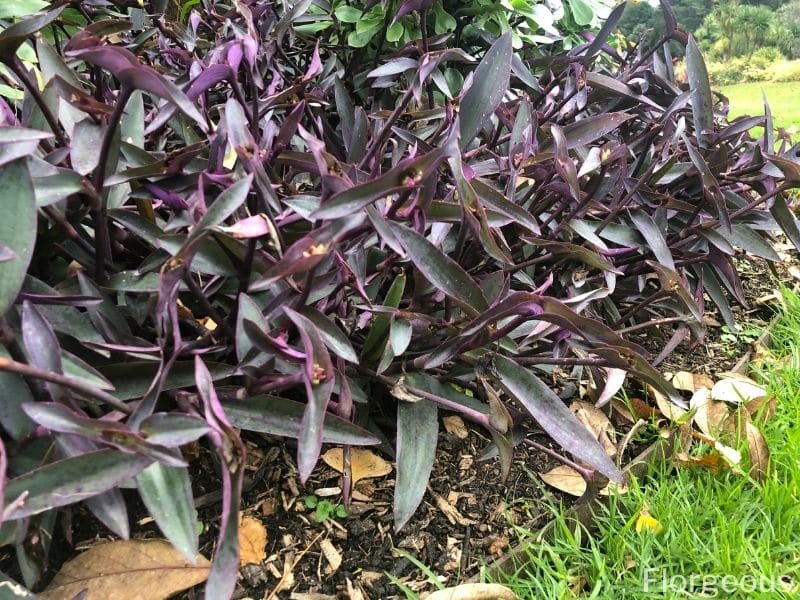
The leaves and stems of this species are in striking deep purple color hence the common name ‘ purple heart ’. Under shaded, they turn a hint of dull green. The leaves are also longer and have wider space in between.
Does Wandering Jew plant need full sun?
Wandering Jew plants (Tradescantia zebrina) prefer bright indirect light but can tolerate some direct sun, especially in the morning or late afternoon. However, prolonged exposure to intense sunlight may cause their dark green leaves to scorch.
How do you care for a wandering Jew plant indoors?
To care for a Wandering Jew plant indoors, place it in a location with bright, indirect sunlight, such as near a window. Water it when the top inch of soil feels dry, typically every 1-2 weeks, and provide well-draining soil. Additionally, mist the plant occasionally to increase humidity and remove dust from the leaves.
How do I make my Wandering Jew fuller?
To make your Wandering Jew plant fuller, prune it regularly to encourage branching and bushier growth. Pinch off the tips of the stems or trim back leggy growth to promote new growth and create a more compact appearance. You can also propagate wandering jew cuttings to create new plants and fill out the pot.
How long do Wandering Jew plants live?
Wandering Jew plants are generally long-lived when provided with proper care. With the right growing conditions indoors, they can thrive for several years, often becoming fuller and more lush over time with regular pruning and maintenance.
Reference List
(1) Dash, G., et. al. Tradescantia zebrina: A Promising Medicinal Plant. 2017. IAJPS, 4 (10). P. 3498-3502 .
(2) Arakelyan, H. Tradescantia zebrina- Mother Nature Healing. 2019. Researchgate.
(3) Vermeulen, N. Encyclopedia of House Plants. Taylor and Francis. 1999. P. 320.
(4) North Carolina State Extension. Tradescantia zebrina. NC State University. 2018. https://plants.ces.ncsu.edu/plants/tradescantia-zebrina/ . Accessed on 12 August 2020.
(5) The State of Queensland. IPA-Zebrina. Department of Agriculture and Fisheries. 2020. https://www.daf.qld.gov.au/__data/assets/pdf_file/0020/51284/IPA-Zebrina-PP102.pdf . Accesed on 12 August 2020.
Photo by Wirestock/depositphotos
Have you seen these?
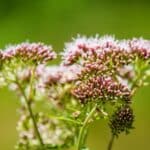
Top 5 Milkweed Companion Plants for Butterfly Garden
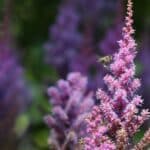
Top 7 Astilbe Companion Plants and What Not to Grow
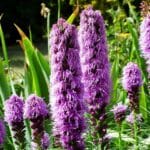
Top 5 Liatris Companion Plants and Creative Ways to Plant Them
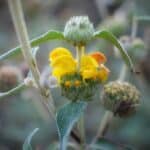
Top 5 Jerusalem Sage Companion Plants
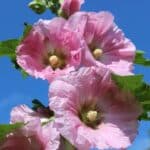
5 Best Hollyhock Companion Plants for Stunning Flowerbeds
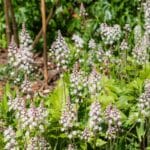
Top 5 Foamflower Companion Plants and What Not to Grow
About the author.
FLIP: Florida Invasive Plants


Tradescantia fluminensis
Common Name(s) : Small-leaf spiderwort, wandering jew
Tropical South America
Ecological Impact
Occurs most densely in partial or full shade of disturbed and undisturbed hammocks, particularly in moist or wet areas but also in well- drained woodlands and shady residential yards. Forms dense monocultural ground cover that can be 60 cm (2 ft) deep in overlapping leafy stems (Kelly and Skipworth 1984). Smothers native ground cover and seedlings of overstory species (K.C. Burks, Florida DEP, personal observation; Godfrey and Wooten 1979). Once established, difficult to control without nontarget damage (J. Weimer, Paynes Prairie Preserve, 1996 personal communication). Listed as a categroy I invasive species by Florida Exotic Pest Plant Council (FLEPPC).
Description
Creeping, trailing, subsucculent perennial herb, much branched, with branch tips erect; often forming dense ground cover; prostrate stems rooting freely at nodes. Leaves parallel-veined, alternate, simple, all glossy green or tinged with purple below; leaf blades arising from short, closed shealths (tops often ciliate); blades to 5 cm (2 in) long and 2 cm (0.75 in) wide, oblong to ovate, with tips pointed; glabrous or with ciliate margins. Flowers white, in small clusters at small tips, subtended by 1-3 leaflike bracts similar in size and form to stem leaves; 3 sepals and petals, separate; sepals usually with a line of hairs; 6 stamens, white bearded (pilose); ovary 3-celled, 6-seeded. Fruits small, 3 parted capsules; seeds black, pitted.
Identification Tips
Leaves are alternately arranged along the stems and have shleathed bases. Flowers are arranged in small cluster near the tip of the stems.
Recognized in 1947 as a common weed under benches in commercial greenhouses and as naturalized in the Southest (Bailey and Bailey 1976). Still cultuvated, most often as a house or patio plant.
Found most abundantly naturalized in north central Florida, from Gainesville to Orlando, but documented by herbarium specimens for 10 counties, including Leon and Calhoun in the Panhandle, Flager on the east coast, and Hillsborough on the west (Wunderlin et al. 1995). Reported by conservation-area managers primarily for Alachua and Marion counties (EPPC 1996), with several dense populations noted in bottomland forests.
Management Strategies
Do not plant. Any fragments removed should be disposed of properly as to prevent reinfestation.
Most photos courtesy of the Atlas of Florida Plants ; click for additional plant details.

Florida Invasive Plants
Grow. Play. Every Day!

- House & Home
- Houseplants
Wandering Jew Care: How to Grow a Long and Luscious Inch Plant (Tradescantia Zebrina)
Tradescantia zebrina (commonly known as wandering Jew, spiderwort, or inch plant) is popular for a reason: This beginner-friendly houseplant is low-maintenance and grows quickly. It’s also super easy to propagate more plants so you can fill your home with more of the colorful striped foliage the species is known for.
Written by Linda Ly

When it comes to vigorous, colorful, and easy-to-grow hanging houseplants, there aren’t many that can compare to Tradescantia zebrina (known more commonly as wandering Jew—and I’ll touch on the history of that name below). Whether you’re a houseplant beginner or a veteran, most indoor gardeners have owned one of these potted plants at some point.
Keep reading for everything you need to know about Tradescantia zebrina and growing this stunning houseplant in your own home.
Disclosure: If you shop from my article or make a purchase through one of my links, I may receive commissions on some of the products I recommend.

About inch plants
Natural habitat.
Tradescantia zebrina is a native of Central and South America, from Mexico down to Colombia, as well as the Caribbean. Here, it forms part of the undergrowth in lightly forested and often very moist areas. It can form very dense, wide mats thanks to its creeping growth pattern and ability to throw roots extremely quickly.
Unfortunately, its vigorous growth has also made Tradescantia zebrina an invasive plant in some regions. This includes Hawaii, Brazil, and Australia, where the species easily takes hold in moist, forested areas.
As a 2019 study carried out in the Brazilian Atlantic Rainforest notes, this is problematic due to the species choking out native plants.
Some of the above was caused by careless gardeners allowing bits of the plant to get into the wild, where they quickly root. If you’d like to grow spiderworts like this one in your garden, please make sure to dispose properly of any trimmings left after pruning!
This also applies to zebrina’s popular cousins, like Tradescantia fluminensis, T. pallida, and T. spathacea.
Description
It’s not difficult to see why Tradescantia zebrina gained popularity as a houseplant. Wandering spiderwort plants (not to be confused with spider plants , another beginner-friendly species) are low-maintenance and grow just about anywhere—they even just grow in water !
Easy care and quick growth aside, spiderworts are also just good-looking plants. The pointed, oval leaves on thin, fleshy stems overlap slightly and are characterized by their zebra pattern in purple and silvery green. The leaf undersides are deep purple in color and the tiny, three-petaled flowers are bright pink.
Although this species is naturally a creeping plant, it’s often grown indoors in hanging planters. As long as the plant is provided with enough light, the foliage will be very dense and brightly colored, forming a spectacular waterfall that can reach more than 3 feet in length.
What’s in a name? In the case of common houseplants, sometimes a lot.
Tradescantia zebrina is a classic houseplant (I found mention of it in a 1964 German book about houseplants, but it’s probably been around longer than that!) and among most English speakers, it has long been known as wandering Jew. This is probably a reference to the “wandering” nature of the plant, as it does have a creeping growth pattern.
The legend of the wandering Jew is hundreds of years old and is now commonly considered to be rooted in antisemitism. It describes a Jewish man cursed to walk the planet until the Second Coming because he taunted Jesus on his way to the cross.
Because of this, the plant name has partly fallen out of fashion and has been the source of much debate in the plant world over the past few years.
Some plant enthusiasts have embraced the alternative “wandering dude,” which I personally think is a great option.
“Inch plant” (houseplant enthusiasts don’t agree on whether this refers to the fact that it can grow an inch a day, or that you only need an inch of stem to propagate it), “spiderwort,” or “wandering spiderwort” are also popular alternatives, though these are common names for other Tradescantia varieties, such as Tradescantia Nanouk.
The best way to avoid any confusion is to just stick to the scientific name.

Inch plant varieties
There are three subspecies of inch plant (wandering Jew): Tradescantia zebrina var. zebrina, var. flocculosa, and var. mollipila. Unsurprisingly, after it having been a popular houseplant for so many years, nurseries have also managed to create a whole bunch of cultivars through selective cultivation.
A few of the popular Tradescantia zebrina cultivars you may come across in your local plant store include, but are certainly not limited to:
- Tradescantia zebrina ‘Quadricolor’: Yep, as the name suggests, this one adds an extra color to the mix. The leaves are cream, pink-purple, light green, and dark green.
- Tradescantia zebrina ‘Burgundy’: Characterized by its very dark purple coloration.
- Tradescantia zebrina ‘Silver Plus’: Less purple, more shiny silver.
- Tradescantia zebrina ‘Red Gem’: Less silver, more intense (light) purple.
- Tradescantia zebrina ‘Purple Joy’: Less silver, more dark purple.
- Tradescantia zebrina ‘Tikal’: A rare, naturally occurring variety that collectors pay a pretty penny for.
Do keep in mind that most of these cultivars aren’t patented and the amount of mislabeling and variation within a cultivar are both huge. Just growing your wandering Jew in lower-light conditions can completely change the way it looks, so it’s not surprising that confusion sometimes reigns supreme.
Luckily, care is the same across all cultivars, so your best bet is to just enjoy your plant even if you’re not sure what Tradescantia variety you’re dealing with!
Where to buy wandering Jew plants:
- California Tropicals
- Daylily Nursery
- The Green Escape

Caring for an inch plant
Light and temperature.
It’s important to provide your Tradescantia zebrina with enough light. It’s tempting to use plants to brighten up dark, shaded spots in your home, but that just doesn’t work with this one: It loses its dense growth pattern and beautiful coloration in low light.
To prevent your wandering dude plant from growing sparse and green, place it near a window that gets bright indirect light. Some full sun isn’t a problem either, but do make sure you acclimate it gradually to a higher light location.
Temperature-wise, this species is a lot hardier than many of the tender tropicals we like to grow in our homes (like Anthurium andraeanum and Begonia maculata ).
Wandering dude plants can handle a very wide range of temps, making it perfect for those chillier windowsills that your other plants may not appreciate. Room temperature is ideal, but anything between 50°F to 85°F will keep them happy.
Water and humidity
Your Tradescantia zebrina will appreciate lightly moist soil. You can water a bit more during the summer months, when the plant is actively growing and needs a lot of moisture, and less during winter, when soil tends to take significantly longer to dry.
If you’re not sure whether it’s time to water your wandering Jew plant yet, you can always turn to the age-old trick of sticking a finger in the soil.
- If it still feels damp, wait a little longer, until the first inch or two has dried.
- If it feels bone dry, you’ve waited too long; you may also see limp leaves on your plant at this point. It’ll bounce back, but not always without lasting damage.
- If the soil feels wet, you watered too much and need to keep an eye out for root rot.
As for humidity, given its rather wet natural habitat, wandering Jew does appreciate higher air moisture levels. The great thing is, though, that it doesn’t demand it. As long as you keep its soil lightly moist and the air isn’t extremely dry, your plant should do well.
Soil and planting
Wandering Jew is not fussy about its potting mixture at all. I’ve grown it in pure houseplant potting soil with no additives. If you do want to take things to the next level, you can add some perlite and/or peat moss, although this is really not a must.
Most houseplant enthusiasts like to place their wandering Jew in a hanging planter so they can enjoy the look of the leaves cascading down. This is not a must, though. You can also emphasize the species’ creeping growth habit by filling up a large, shallow planter, growing it in a terrarium, or even keeping it in water on a semi-permanent basis.
Recommended products for wandering Jew plant care:
- FoxFarm Ocean Forest Potting Soil
- Espoma Organic Potting Mix
- Perfect Plants Organic Perlite
Fertilizing
Like most other houseplants, Tradescantia zebrina appreciates a bit of fertilizer during the growing season, which extends from spring to early fall. You can use a normal houseplant fertilizer according to the instructions on the bottle.
Don’t fertilize during the winter months unless your plant is growing well. It doesn’t need extra nutrients if it’s inactive.
Recommended fertilizers for wandering Jew plants:
- Houseplant Resource Center Liquid Fertilizer for Houseplants
- Instant Biologics Instant Plant Food (Fizzing Nutrient Tablets)
- Maxsea All-Purpose Seaweed Plant Food
Pruning
There’s a good chance you’ll have to prune your Tradescantia zebrina regularly, because as I mentioned, this is a very quick grower. It also roots very easily, so any trimmings can be replanted! I’ll describe how to do this in the section on propagation below.
Aside from stem trimming, you can remove any dead leaves, which are bound to pop up from time to time in very dense plants like this species.
Dividing or repotting
Inch plants don’t grow by producing plantlets at their base like many other houseplants (such as spider plants ) do. Instead, inch plants spread by rooting along the stems.
This means that division is not really the way to go; keeping these plants manageable is usually done through pruning. You can shape your plant by pinching off any long, leggy stems to create a fuller appearance and control its spread.
You’ll notice that Tradescantia really doesn’t mind being a bit cramped in its planter. Still, it’s a good idea to provide your plant with some fresh soil every year or two by repotting it.

Propagating an inch plant
If you’ve never propagated a houseplant before, this is truly one of the best species to start with. It’s known for rooting extremely quickly in both water and soil, meaning it’s easy to fill endless planters to keep or give away.
All you need to propagate your Tradescantia zebrina is a pair of clean scissors. Here’s how you do it:
- Snip the ends off existing branches. An inch or two with a few leaves works best.
- Remove the leaves at the bottom so part of the stem is exposed.
- Place the cutting in a glass of water to root or plant it directly in soil. You can put cuttings back in the mother plant’s pot to give her a fuller appearance on top.
- It can take a little longer during the winter months, but the first roots should appear within a week or so. You can give soil cuttings a slight tug to verify they’ve rooted.
- Once the first signs of new foliage appear, you’ll know your propagation attempt has been a success!
- If you propagated in water, you can leave the rooted cuttings in water almost indefinitely, although you can also pot them up in fresh soil.

Common questions about inch plant care
How do i make a wandering jew plant bushy.
By their very nature, wandering Jew plants are not bushy. Their creeping growth habit means they naturally grow leggy over time, especially in containers.
However, you can mimic a fuller appearance by strategically pinching off any long, spindly stems to shape the plant more. These stems can also be replanted near the mother plant.
As the baby plants grow, they’ll help fill in sparse areas and create the illusion of a bushy wandering Jew.
How long do wandering Jew plants live?
Wandering Jew plants have a limited lifespan of just a few years, and as a potted plant, you’ll notice your wandering Jew becoming very leggy after just two to three years.
Unlike other fast-growing plants that benefit from pruning, cutting back a wandering Jew doesn’t work well to renew its growth; it simply controls the spread.
The best way to keep your plant coming back year after year is to propagate new plants from stem cuttings, which—fortunately—is super easy with a high success rate.
Is wandering Jew perennial?
Wandering Jew (Tradescantia zebrina) is a trailing evergreen perennial in its native habitat (USDA hardiness zones 9 through 12). Where it’s not winter hardy, wandering Jew is grown year-round as a houseplant.
Are wandering Jew plants toxic to cats and dogs?
Wandering Jew is not considered outright toxic, but it can cause some skin irritation. If your pet gets into your plant, don’t worry too much, although it can be a good idea to have a look in its mouth to make sure there’s no excessive swelling. Be sure to offer water. To prevent skin rash, it can be a good idea to wear gloves if you need to handle your wandering Jew plant. This especially applies if you have sensitive skin.
https://www.cabi.org/isc/datasheet/110354
Racism in Taxonomy: What’s in a Name?
Chiba de Castro, W. A., Xavier, R. O., Garrido, F. H., Romero, J. H., Peres, C. K., & da Luz, R. C. (2019). Fraying around the edges: negative effects of the invasive Tradescantia zebrina Hort. ex Bosse (Commelinaceae) on tree regeneration in the Atlantic Forest under different competitive and environmental conditions. Journal of Plant Ecology, 12(4), 713-721.
Encke, F. (1964). Pflanzen fur Zimmer und Balkon; Auswahl, Pflege, Vermehrung.
I'm a plant lover, passionate road-tripper, and cookbook author whose expert advice and bestselling books have been featured in Time, Outside, HGTV, and Food & Wine. The National Parks Cookbook is my latest book. Garden Betty is where I write about modern homesteading, farm-to-table cooking, and outdoor adventuring—all that encompass a life well-lived outdoors. After all, the secret to a good life is... Read more »
We bought a full grown Bolivian Jewel mid summer last year. It was in a 14” raised pot and flowing 2 foot over the sides. It was beautiful next to our fountain outside. We live in Minnesota so we had to discard it in the late fall since we had no place to care for it in the house. Since we can’t find another like it we’d like to plant one from scratch but how. We still have the pot and riser but have no idea how to start from that. One plant, a few or just how many to make a bushy over grown plant so it looks like the one we purchased last year. Does this make sense or should we just forget it since it is already the middle of May. The greenhouse that we bought it from last summer doesn’t have any this year, just small ones in 4” pots. Thanks
If you can only grow it as an annual (and won’t be overwintering it indoors), you can plant a few smaller ones together to make them look fuller as they grow.
It seems counterproductive to talk about the problematic origin of the name wandering Jew, recommend multiple alternative names (including scientific), but then continue to call it wandering Jew in the rest of the article. If the name is anti-Semitic just set a good example and use a different name.
Leave a Reply Cancel reply
Your email address will not be published. All fields are required.
Save my name and email in this browser for the next time I comment.
This site uses Akismet to reduce spam. Learn how your comment data is processed .
Recommended Reads
- Garden of eatin’

The No-Dig Garden Method: Make Amazing Soil With Less Work

Solarizing Your Garden: How to Use the Sun to Control Weeds and Pests in the Soil

How to Plant a Three Sisters Garden: The Original Companion Plants

How Much to Plant for a Year’s Worth of Food

What You Should Know Before Buying Land (My Real-Life Tips)

Construction Loans: What I Wish I’d Known As a First-Time Borrower

Dark Room? 9 Actually Low-Light Plants That Don’t Need a Lot of Sun

Getting Rid of Fungus Gnats: 11 Remedies That Really Work

My Favorite Ruby Red Sauerkraut Recipe (and Why It’s So Good For You)

How to Make Nukadoko (Fermented Rice Bran Bed) for Pickling

Easy 4-Ingredient Colorful Homemade Pasta—No Pasta Maker Needed

The Best Homemade Limoncello
Want to level up your garden this year.
Sign up for my free, never-boring newsletter and every week you’ll get the game-changing emails you wish you would’ve had sooner.
- About Linda Ly
- What’s In My Garden
- Lazy Gardening Academy
- Sponsorships
- Site Policies

Back to the top
Disclosure: Garden Betty independently selects products to feature on this site. I may receive a commission when you buy something through one of my links. As an Amazon Associate, I earn from qualifying purchases.
© 2024 Garden Betty. All Rights Reserved.


Order Your Almanac Today!
Caring for Wandering Dudes (Inch Plants)

Sign up for our daily newsletter to get gardening tips and advice.
Growing Wandering Dude Plants (Tradescantia Zebrina): Watering, Propagating, Lighting, and More
Tradescantia zebrina (wandering dude) is a type of spiderwort known for its attractive purple- and silver-striped foliage. This houseplant, also called in “inch plant,” knows how to survive any indoor environment and is perfect for the wanna-be-green thumb! Here’s how to care for an inch plant in your home.
About Tradescantia or Inch Plant
Tradescantia zebrina (pronounced trad-es- KAN -tee-uh zeb- REE -nuh) is a species of creeping plant in the Tradescantia genus. Common names include wandering jude and inch plant. This plant was formerly called Zebrina pendula and wandering Jew. Another common name is Variegated Spiderwort.
While Tradescantia zebrina is a perennial plant in its native Mexico, its treated as a houseplant in North America, and commonly grown in a hanging pot. It is considered invasive species in warm regions outside of their home ranges (including in parts of the southeastern U.S. ). For this reason, we recommend growing inch plants indoors or keeping them restricted to containers outdoors.
Not only does the inch plant have attractive leaves but it’s fast-growing, with trailing stems. Leaf nodes on the stem are supposed to be 1-inch apart, hence the common name inch plant. Each segment is capable of producing a new plant, so Tradescantia is e asily started from cuttings that root readily in moist soil.
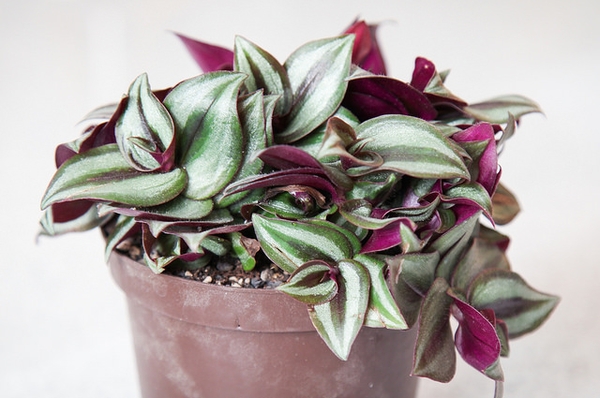
Shamrocks and Four-Leaf Clovers: What's the Difference?
Easy houseplants for your home, 20 easy-to-grow perennial flowers for beginners.
- Grow in all-purpose indoor potting mix in either a pot or hanging basket.
- Select a location with filtered sun. Keep inch plants out of direct sunlight and out of dark areas, which will cause them to become leggy.
- The room temperature should be average (between 55° and 75°F).
- Water deeply, but allow the soil to dry partially before watering again. This plant doesn’t like to dry out, but it also doesn’t like to be constantly wet.
- Water less during the winter months, which is the plant’s resting period.
- Provide fertilizer twice a month in the spring and summer; don’t fertilize in fall and winter.
- Pinch back to keep this trailing plant contained as well as promoting bushier foliage.
- Removed leggy growth also allows for cuttings that can be used for propagation.
- Plants can be pruned back hard every spring and can be taken outside on a protected patio in the summer.
- Tradescantia zebrina ‘Tricolor’ (pictured at the top of this page) has beautiful purple and green leaves with shiny silver stripes.
- Tradescantia pallida ‘Purple Heart’ has fuzzy, purple foliage.
- Tradescantia fluminensis ‘Quicksilver’ has variegated white-green foliage.
- Inch plants can easily be propagated by cuttings. Snip off a piece of the plant (the cutting should ideally be 3–4 inches long) and place the cut end in water. In about a week (or less), the cutting should produce roots. A week or so after that, plant the cutting in a pot according to the planting guidelines above.
- No serious insect or disease problems.
- Aphids tend to be a problem on the stems and leaves. Monitor for aphids (and other small insects), as they could become an issue if unchecked. To get rid of them, pinch off the infected stems and spray the plant with water.
- Root rot and stem rot can occur in soggy soil.
- Note that contact with plant sap causes skin irritations in some individuals.
Catherine Boeckmann

ADVERTISEMENT

50 Fall Flowers and Plants for Autumn!

Top Succulent Plants for the Home

How to Propagate Plants From Cuttings

I am not about to call a plant "dude". Stop being ridiculous, stop with the DIV garbage. Keep your roots.
I love the Wandering Jew hanging baskets. Last year they were priced at $40 a basket and I have 3 baskets and was not paying that much so when it came time for the first frost and the leaves started browning I clipped about 25 or so cuttings and put them in juice glasses on my dining table. I changed the water regularly but the whole winter they stayed in the juice glasses in a place with indirect sunlight. In early spring I transplanted them into the baskets with potting soil and some fertilizer. They were tiny little spindles and now they are thriving! I love them!
We love how quickly the inch plants grow and propagate! Thank you for sharing your story with us.
- Jenn, Associate Digital Editor
A good article on the care of the wandering Jew plant. Although, I would like to add, that the branches of this plant are extremely tender. And you can break them off, just buy a glance. So I would caution anyone, to handle them with care. Once it's established as a full-sized plant, it's a more little hardy. But, as a young cutting. Those stems are very tender.
Just because something has "always been this way" or you're old is not a good reason to continue. We constantly learn and evolve our language. The National Gardening Association (NGA) and a number of professional horticulturalists have acknowledges this. Unless you're a plant person or Jewish, I'm not sure you would know. I'm glad the Almanac's forward thinking and not anti-semitic; it may take a few years for regular people in plant stores to catch up. As someone else said here, "Just because you find something inoffensive doesn't make it so."
The genus Tradescantia commemorates John Tradescant the Elder (1570s-1638). Massively famous and significant. An extraordinary plant hunter and master gardener who began his career as head gardener to Robert Cecil, 1st Earl of Salisbury ... gardener to the royal favourite George Villiers, 1st Duke of Buckingham ... Keeper of his Majesty's King Charles I's Gardens, Vines, and Silkworms ... the Oxford Physic Garden. His royal patrons sent him all over to collect for their gardens and greenhouses -- the Low Countries, Arctic Russia, the Levant/North Africa. With his son, maintained their own garden and museum in South Lambeth, known as the Tradescants' Ark -- the first public museum in Britain. The common house plant under discussion here was sent to him by a friend in Virginia (it is indigenous to Mexico); another friend sent the scarlet runner bean from the West Indies. His son, John Tradescant the Younger, was also a traveller (mostly to North America), plant hunter, master gardener. Their huge museum collection went to Elias Ashmole and became the foundation of the Ashmolean Museum in Oxford. This link lists some of the 750 species they brought to England: https://people.elmbridgehundred.org.uk/biographies/john-tradescant/ They were just as famous for the numerous "rarities" in their large museum of the world, among which is one of the few specimens of the extinct dodo. Their travels explain the "Wandering" part of the houseplant's name. Were they Jewish? If they were Jewish in 17thC England, it would likely have been a private matter. Casual research turns up nothing certain, only this suggestion from a 1638 visit: "The Christian world is also indebted unto that painful industrious searcher and lover of all nature’s variety for the late knowledge of the spiderwort..." -- though that might only signify collection from nonChristian territories. (You can find the whole letter here: https://thejunket.org/2015/01/issue-thirteen/tradeskin/.) But I would like to think they were.
"some PC nonsense... forced on the public" and "a perfectly good name and there's nothing offensive about it"
The name refers alternatively to the legend that a Jew mocked Jesus on the way to the cross and was forced to wander the Earth until the apocalypse or to the supposed itinerant, rootless nature of Jews. There are centuries of stereotypes built around these myths. Please consider that the world is larger than what you know. Just because you find something inoffensive doesn't make it so.
Thank you for the information you provided about the name “Wondering Jew” I did not know this..was very interesting. I was just going to post on social media about my plants didn’t know the correct name I didn’t want to offend anyone reading this put my mind to ease. Again thank so much for your comment.
It has been called the wondering Jew as far back as I can remember how on earth did they come up with the inch plant really!!!
How did they come up with inch plant? It's literally in the article that "Leaf nodes on the stem are supposed to be 1-inch apart, hence the common name inch plant". Yet you think "Wandering Jew" is a great descriptor of a plant? Considering the term is based on anti-Semitism I'm surprised anyone would argue for continuing to use a term once ignorance of it's impact can't be an excuse. To knowingly say that your desire to say words outweighs someone else's desire to not be subjected to casual racism is unbelievably selfish. When offered the chance to be better, to do better, why on earth would you not take it?
- More Comments

Urbane Jungle
In a world of towering brick and concrete edifices, sometimes one needs a little bit of plant life
Tradescantia: Wonderful Wanderers
02.07.2018 by rzr5355 // Leave a Comment

Solid, striped, or variegated; burgundy, emerald, lilac, and (sometimes or) white; and almost always pointed. The leaves of Tradescantia species come is a vast array of appearances and hues which dazzle the eye and draw many a plant-lover near. Now, these unique descriptions may cause you to believe that these lovely specimens are rare pieces of small gardening collections hoarded away from the eye of the general public; however, it is rather likely that you have encountered at least one cultivar of this ever-popular genus in your wanders through the wilds of your local gardening center.
All About Tradescantia
Known more widely as inch plant, spiderwort, or “wandering jew,” Tradescantia are a genus of around seventy-five perennial flowering plants native to the regions between Canada and mid-South America. The genus became more well-known during the 1600s, during which foreign trade introduced the prior unknown beauties to Europe. It was during this very same period that the genus’s popularity began to take root and, subsequently, these colorful, winding wonders trailed their way into the hearts of green thumbs and the environments of locales across the globe. This, unfortunately, has caused some species to become invasive and cause unrest in those ecosystems where it survives a little bit too successfully. (A kind thanks to Wikipedia for giving me the most quintessential knowledge I can’t seem to dig up on more “academic” sites!)
If you are anything like me, you are likely wonder why in the dickens these plants are known as “wandering jews.” Jackie Rhoades of Gardening Know How shares the story of the namesake in the post “ Growing Wandering Jew Houseplants .” Simply put, women of the home we quite adept at growing the plants and would share their clippings with one another, thereby allowing the houseplant to spread in a manner similar to that of historic members of the Jewish community.
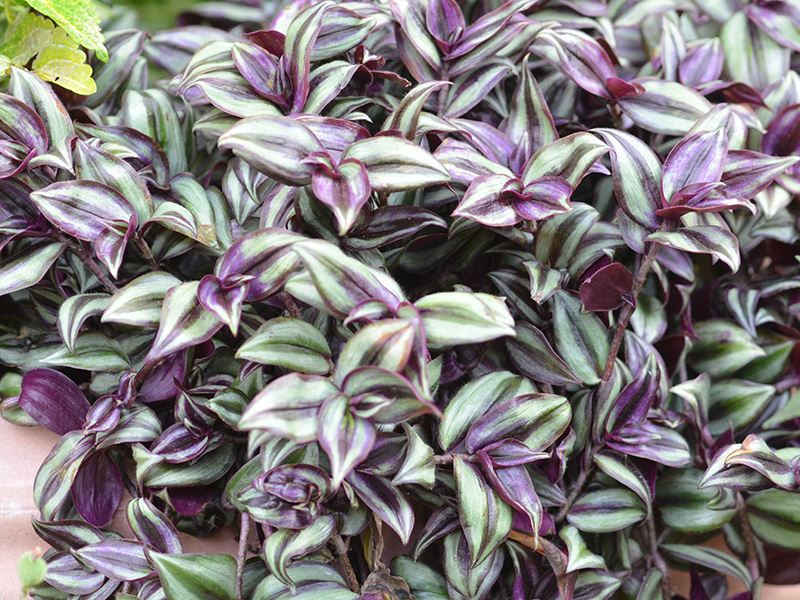
Tradescantia are widely known to be of insubstantial need; they are, in nature, wildflowers which trail and vine, after all. Despite the this self-preserving, low-maintenance facade, though, some small eccentricities have slightly swayed the genus’s total ease of care and necessitated a tidbit of attention on the part of jungle caregivers.
For Tradescantia , the most basic requirements, soil, is of equally basic need. Genus members grow best in a well-draining general purpose potting soil, but they can also do extremely well in soilless mediums as a result of their abilities to drain. Container size is not typically an issue and many cultivars can be placed in hanging baskets or pots one size up from their nursery pots to contain their growth.
One such peculiarity comes in relation to the watering preferences of the plants: they really don’t like wet feet and really, really don’t like to be watered at the base of their stems , known as the crown of the plant. At this point, you have probably heard my spiel about root rot and how plants (usually) don’t like to have water sitting in their containers; this also applies to Tradescantia . Beyond these small finicky pieces, the genus likes to be watered deeply, drained well, and misted to raise the surrounding humidity. During the dormant season (winter), watering should be reduced to accommodate for the plant’s growth stagnation, though.
Fertilization of the plant is not entirely necessary, but can be done up to twice monthly with a diluted solution of general-purpose houseplant fertilizer.
The sunlight and temperature requirements of Tradescantia are straightforward. All members of the genus prefer bright, indirect sunlight with the occasional glance of full exposure and all will grow steadily in temperatures ranging between 55 and 75 degrees Fahrenheit.
Unfortunately, Tradescantia are known be become elongated and “leggy” with time due to their trailing nature. Many growers, including The Spruce , suggest pinching the plant to encourage branching of the plant and ensure fullness. When the plant becomes too stretched, though, the issue can be addressed by taking plant cuttings, rooting them in water on a sunny window sill, and replanting when the new roots have grown to one inch in length. For more precise details about propagating, head over to SF Gate ‘s post on Wandering Jew Propagation !
Leave a Reply Cancel reply
Your email address will not be published. Required fields are marked *
Save my name, email, and website in this browser for the next time I comment.
‘Invasive Species’: An Artist Cultivates a Garden of Racist Plants
Oliver Basciano Reviews 23 August 2022 ArtReview
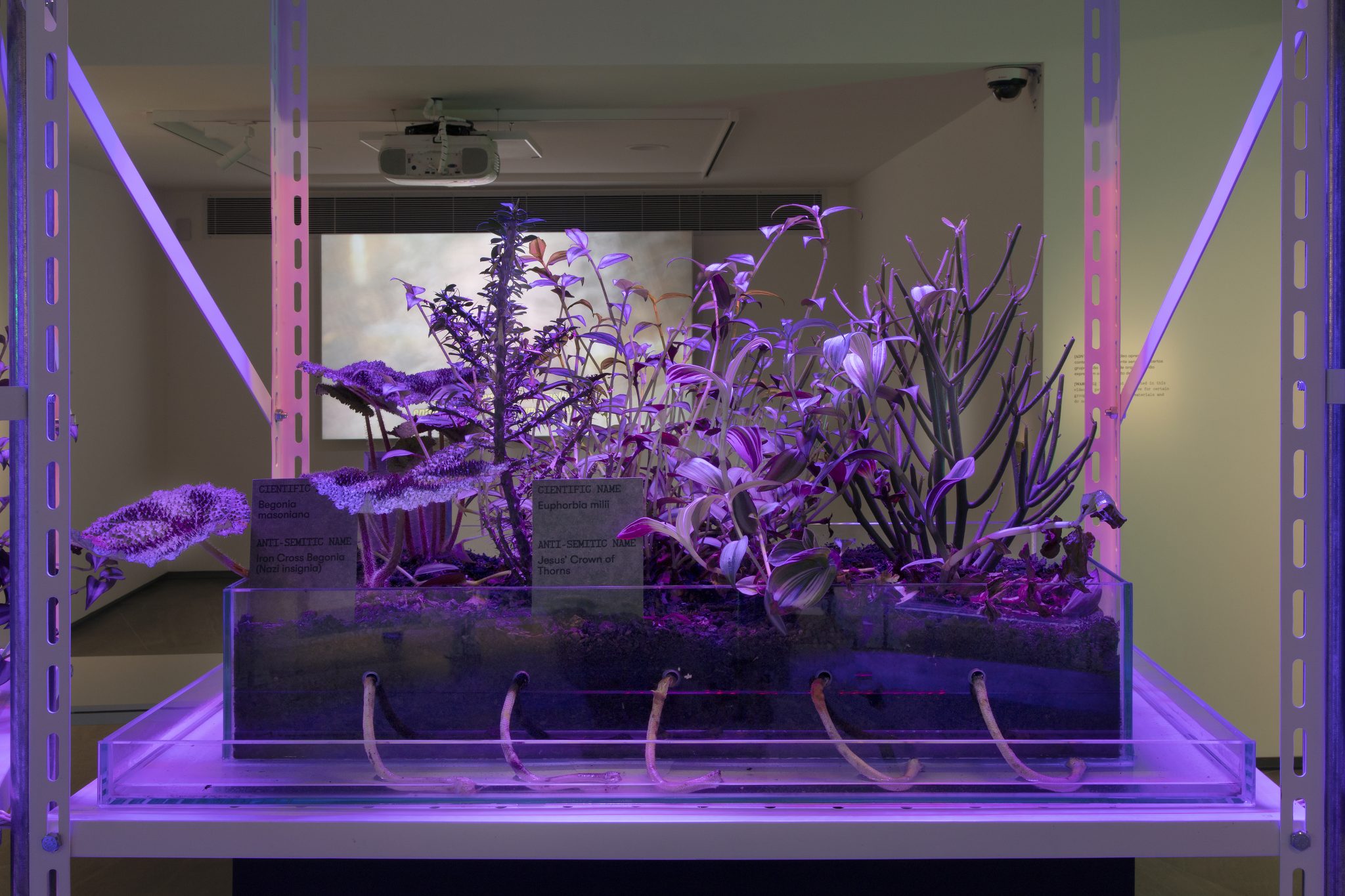
Giselle Beiguelman’s Botannica Tirannica at Museu Judaico de São Paulo explores scientific research as an expression of imperial power
Outside the deconsecrated 1930s synagogue in which the Museu Judaico de São Paulo opened last year, Giselle Beiguelman has planted a garden of weeds. ‘Weeds’ of course is an entirely subjective term, denoting any unwanted wild plant. Inside the building, in front of windows overlooking the exterior beds, the artist provides a ledger, identifying each species with its Latin name and its common name in Brazilian Portuguese (with an English translation). Among them: Wandering Jew ( Tradescantia zebrina ), Gypsy Braid ( Senecio jacobsenii ), Jew’s Thorn ( Euphorbia tirucalli ), Lady of the Night ( Cestrum nocturnum ). Inside the rotunda gallery, other shrubs and greenery, each with names similarly referencing specific groups of people, grow inside tanks installed on a central circle of metal shelving units. Those historically labelled with anti-Semitic references were invariably ‘invasive’ species – a trait that can be found also in the common names for plants in English and other languages – prone to take over a garden where the green-fingered were not careful to control them. Botany as a site for anti-Semitic prejudice. Other plant names nod to physical caricatures. In Brazil the ornamental Thunbergia alata flower, with its big wide yellow petals that conjoin in a dark central hole, is known as the ‘Mulatto girl’s bottom’ (‘mulatto’ refers to people of mixed African and European ancestry); the tangled climbing vines of Muehlenbeckia complexa is referred to as the ‘Cabelo-de-negro’ (‘Hair of a Black Man’). This caricature of the Black body summons up histories of exoticisation and slavery.

The offensive nomenclature of botany is merely symptomatic of prejudice passed through generations. To this Beiguelman adds questions of colonialism through a series of botanical drawings of similarly offensively named species, hung on the surrounding gallery walls, the medium recalling the adventures of colonial-era botanists whose research was as much an expression of imperial power as it was scientific curiosity: to name and categorise is to give yourself the structure to govern and rule. The subsequent exploitation of the indigenous plants is signalled in a collection of seeds and herbs derived from plants that proved to have economic value; the dehumanising names (a jar of Brazil nuts labelled with an old name employing the N-word; a pot of ‘kaffir’ lime leaves) a means of legitimising exploitation. Yet Beiguelman’s concerns go beyond the legacies of historical prejudice via a series of AI-generated videos, playing out looped on monitors that sit alongside the plants on the metal racking. The videos feature pictures of ‘Frankenstein’ plants created by algorithms that combine images automatically gathered from the internet (one video, showing a woody-looking fantasy species, takes images of plants that slur indigenous groups as its source material, another images of plants with sexist names and so on). Machine learning, built on datasets steeped in inherited prejudice, Beiguelman suggests, will only perpetuate that thinking. As AI is increasingly used in everything from job applications to crime prediction, there are risks of far more serious consequence than the language of the flower bed.
Botannica Tirannica at Museu Judaico de São Paulo, through 18 September
Most recent
Archie moore’s australian pavilion wins golden lion award at venice biennale 2024.
ArtReview News artreview.com 20 April 2024
The first Australian artist to receive this award

ArtReview Talks with Australia Pavilion at 60th Venice Biennale – ‘Art and Abolition’
ArtReview Partnership with Creative Australia artreview.com 20 April 2024
Reflecting on Archie Moore’s presentation ‘kith and kin’ for the Australia Pavilion, the talks programme will explore two of the exhibition’s central themes
Seller of 145 counterfeit paintings sentenced to 14 months in prison
ArtReview News artreview.com 19 April 2024
Hatch’s sentence begins on 17 June and includes three years of supervised release.

Jonas Staal turns down DAAD residency nomination over anti-Palestine censorship
'I must reject the nomination given to me by your institution, but the invitation to join the side of history that bends towards justice remains always open.'

60th Venice Biennale Review: Who Can Judge?
J.J. Charlesworth Opinion artreview.com 19 April 2024
Adriano Pedrosa’s ‘Foreigners Everywhere’ wants art to speak for everyone, but it’s hard to know what it might actually say

Venice Biennale 2024: A Guide to the Giardini
ArtReview Opinion artreview.com 19 April 2024
The Denmark, Spain, Bulgaria and Poland pavilions – reviewed

National Gallery Singapore at the 60th Venice Biennale
ArtReview Partnership with National Gallery Singapore artreview.com 18 April 2024
ArtReview walks you through some of the works included in Foreigners Everywhere from the National Gallery Singapore collection

Bruce Museum director Robert Wolterstorff to step down
ArtReview News artreview.com 18 April 2024
Wolterstorff joined the institution in June 2019, overseeing its campaign for a major expansion titled ‘The New Bruce’

Ayoung Kim Receives Korea’s Inaugural ACC Future Prize
The award comprises KRW 300 million (USD 210,000), which Kim will use to create a commissioned work at ACC Creation Space 1

Venice Biennale 2024: A Guide to the Arsenale
Alexander Leissle Opinion artreview.com 17 April 2024
The Benin, Türkiye, Argentina and Philippines pavilions – reviewed

- Show search
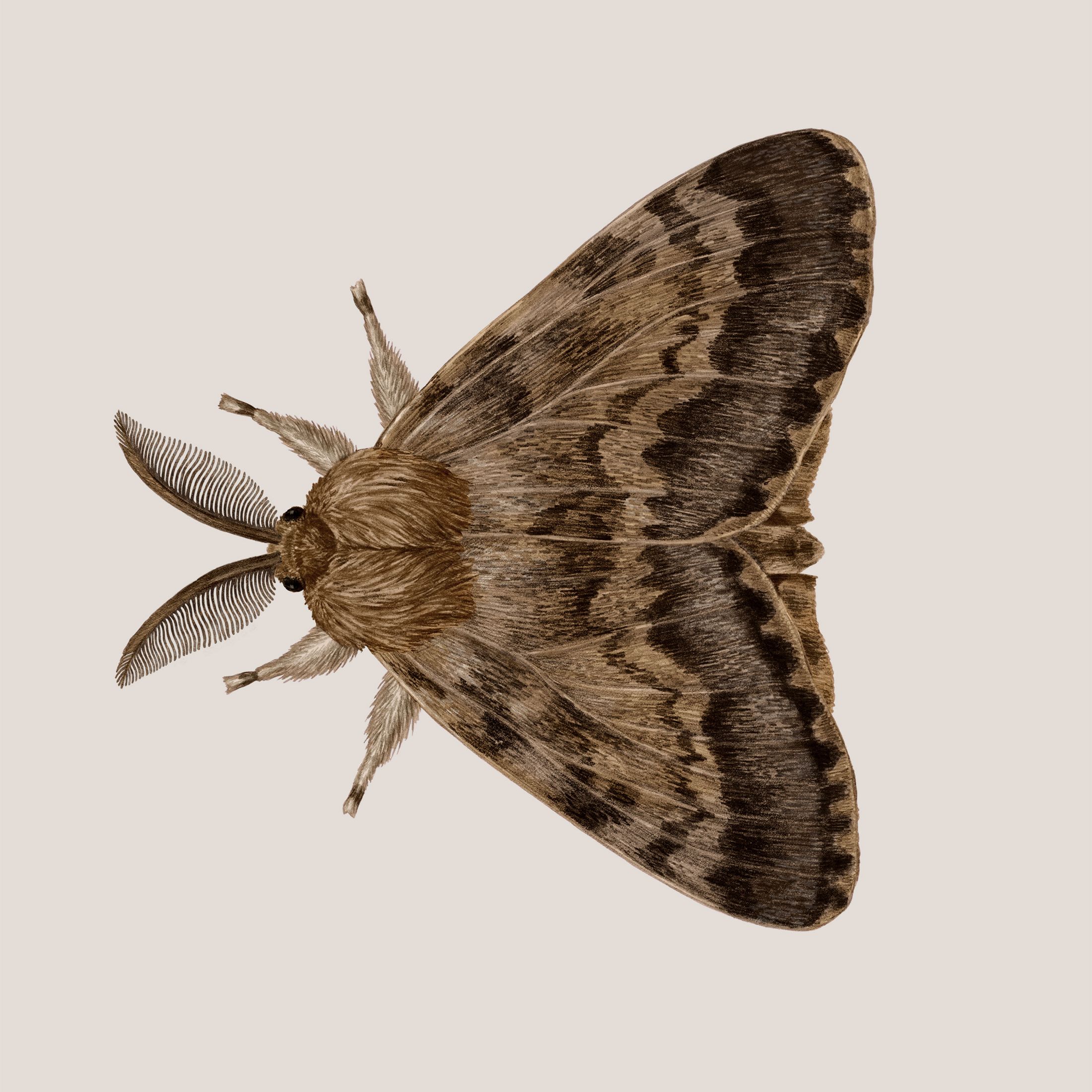
The Movement to Rename Species
The common names of some species have not aged well. These scientists want to change them.
August 25, 2023
Text by Suzanne Goldsmith | Illustrations by Zoe Keller | Fall 2023 Issue
For Stephen Carr Hampton, the Scott’s oriole is a beautiful bird with an ugly name—so ugly, in fact, that he won’t say it out loud.
Hampton, who recently retired from a career at the California Department of Fish and Wildlife, is an avid birdwatcher and enrolled citizen of the Cherokee Nation—he has traced his ancestry all the way back to the Cherokees’ Constitutional Convention in 1827. After the passage of the Indian Removal Act of 1830 and a series of violent raids, Hampton’s forebears were driven out of their homeland in Georgia by the U.S. military. Hampton’s great-great-grandfather, Thomas Jefferson Parks, then 17 years old, drove a wagon that carried his own people to an Oklahoma reservation—part of what would become known as the Trail of Tears. The architect of that cruel process was General Winfield Scott, who had also played a role in the U.S. military effort to push the Seminole out of Florida. Under orders from President Martin Van Buren in 1838, Scott oversaw the brutal campaign to force around 60,000 members of the Cherokee, Muscogee, Seminole, Chickasaw and Choctaw nations from their ancestral homes to lands west of the Mississippi. The forced march and relocation killed thousands, and many more faced starvation, exposure, exhaustion and disease after their arrival.
In 1854, a U.S. Army officer named Darius Couch observed a striking black-and-yellow desert oriole. The bird already had a scientific name: Icterus parisorum . But it had no common name—the name most people use informally to refer to a species—so Couch called the bird “Scott’s oriole,” after his commander, Winfield Scott. Three decades later, when the American Ornithological Union published its first checklist of common English bird names, Scott’s oriole became official.
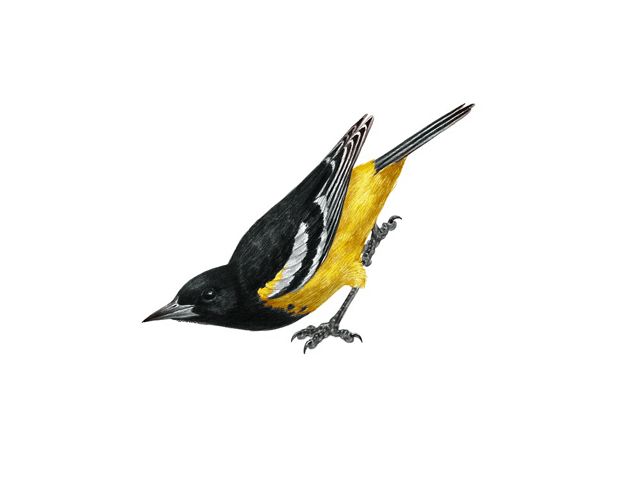
Today, Hampton can’t stomach the name. “There are other Indian-killer bird names, such as Abert’s towhee, Clark’s nutcracker and Couch’s kingbird, or Indian-skull collector names like Townsend’s warbler and Townsend’s solitaire,” Hampton wrote in a blog post in 2021. “It’s hard to be a Native birder in the West and not run into these. But nothing irks me like Scott.” He wants that name changed. And many others agree with him.
The case for changing the common names of animals
In the summer of 2020, amid a nationwide reckoning over race in the United States, 182 birders and ornithologists petitioned the American Ornithological Society to remove all bird names that contain “significant isolating and demeaning reminders of oppression, slavery, and genocide.” But it’s not only birders looking for change. The petition was one of several events that accelerated a broader debate over what to call the plants and animals around us—and what and who we choose to honor and commemorate. The naturalist community has raised a variety of issues with species common names. In some cases, a name simply doesn’t describe an animal very well. In others, as with Scott’s oriole, a legacy of brutality and ethnic cleansing is forever attached. And in still others, where an animal or plant is an invasive species conservationists want eradicated, some fear names that reference foreign countries or ethnic groups could promote xenophobia.
Many of those asking for change argue that these names discourage people from entering the natural sciences or from taking pleasure in nature—often the first step to becoming a conservationist. Their efforts are not proceeding without challenges and accusations of political correctness. But despite pushback, it seems clear that in the coming years, many birds, fishes, insects and places will come to be known by new names.

This Alaska mountain was called Mount McKinley for more than a century. In 2015, its official name became “Denali,” after a traditional Koyukon Athabascan term meaning “the tall one.”
Why some species are renamed
In the world of animal species, scientific names (often in Latin) are regulated by the International Code of Zoological Nomenclature and are usually changed only for taxonomic reasons, such as when a species is subdivided or reclassified. Less than a decade ago, for example, scientists discovered that there were four genetically distinct giraffe species—not just one—and their scientific names changed accordingly. But common names vary from country to country and language to language. They are often certified by regional groups and societies, such as the American Ornithological Society and the Entomological Society of America, which can also change names when deemed appropriate.
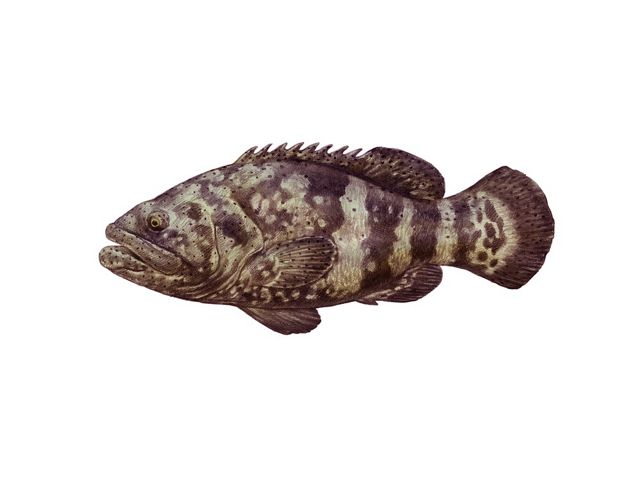
Changing official common names isn’t new. We no longer have a grouper called a “jewfish,” for example. It’s the push for a broader, more proactive approach and a deeper dive into the history of names that is gaining ground now. In 2021, the Society of Ichthyologists and Herpetologists changed the name of its quarterly journal, called Copeia in honor of Edward Drinker Cope, a 19th-century scientist who also produced racist and misogynistic writings. Similarly, the U.S. Fish and Wildlife Service stopped using the term “Asian carp” in official documents in favor of “invasive carp” for the troublesome fish that advocates are trying to keep out of the Great Lakes.
Place names, too, are being scrutinized. In September 2022, the U.S. Department of the Interior announced it would change the names of more than 600 places that contained the word “squaw.” Often used as a slur by white settlers for Indigenous women, the term’s meaning has ranged from “woman” to more demeaning references to “loose women.” In a statement announcing the change, Secretary of the Interior Deb Haaland, a member of the Laguna Pueblo tribe, said, “Racist terms have no place in our vernacular or on our federal lands.”
In 2021, Squaw Mountain in Colorado was renamed Mestaa’ehehe Mountain—“Owl Woman”—following efforts by representatives of the Cheyenne and Arapaho tribes. Once a slur, the mountain now honors an Indigenous woman.
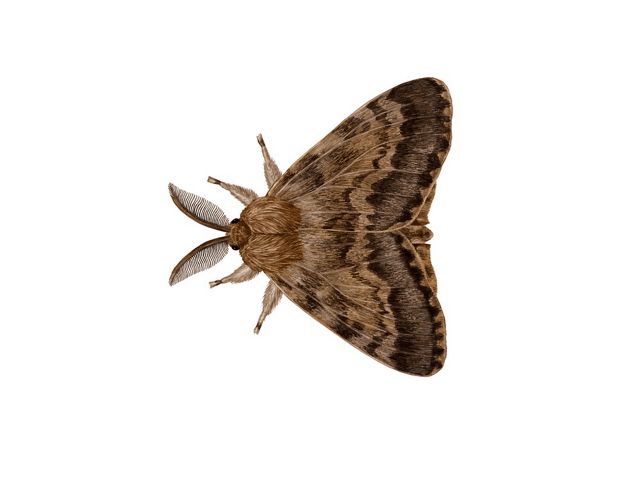
The impact of a name that offends can be far-reaching, says Leigh Greenwood, North American forest pest and pathogen program director for The Nature Conservancy. Greenwood, whose work often involves promoting the control or eradication of invasive species, recently helped petition the Entomological Society of America to change the name of the leaf-munching invasive then known as the gypsy moth ( Lymantria dispar ). Its former name contained a pejorative term for the Romani people, Europe’s largest ethnic minority group.
Greenwood says scientists depend on the public to assist in the control of pests. “The vast majority of invasive species are found not by formalized systems, but instead by interested members of the public,” she says. “We don’t want to alienate anyone in the world of science.”
This issue was on entomologist Chris Looney’s mind when, in late 2019, he learned that a newly discovered invasive hornet in his home state of Washington was being referred to both as a “murder hornet” and an “Asian giant hornet.” The species is indeed fearsome, with a habit of decapitating whole hives of honeybees. To stop its spread, Vespa mandarinia was targeted for eradication in North America in summer 2020.
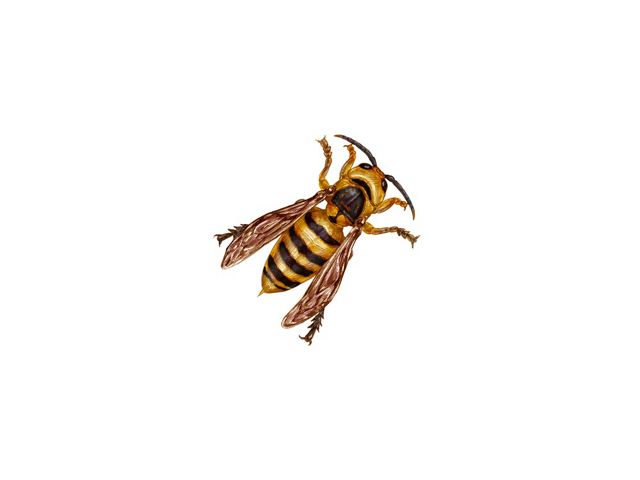
But Looney, who works for Washington’s Department of Agriculture, says the insect’s name was problematic for many reasons. Calling it a murder hornet “stoked entomophobia,” creating overly dramatic headlines and panic. And since most hornets originate in Asia, calling it the “Asian giant hornet” wasn’t very specific. Indeed, entomologists got a late start on eradicating this invasive, Looney says, because one of its earliest sightings was reported as an “Asian hornet,” the common name used for a different invasive species ( Vespa velutina ).
And there was an additional problem: In 2020, amid a climate of fear over COVID-19, which had originated in China, hate crimes against Asian Americans were on the rise. Looney and others, including Greenwood, worried about unnecessarily attaching the “Asian” moniker to a bug that was being dramatized as a “murder hornet” in the news.
In June 2021, the Entomological Society of America launched a solution: The organization’s new “ Better Common Names Project ” set out to identify and change “names that contain derogative terms, names for invasive species with inappropriate geographic references and names that inappropriately disregard what the insect might be called by native communities.” The project took up the issue of the moth, Lymantria dispar , and in March 2022, the “gypsy moth” became the “spongy moth,” in reference to its egg mass.
In May 2022, Looney petitioned the society to name the hornet the “northern giant hornet,” referring to its native range in the northern parts of Asia. He cited the need for clarity, accuracy and cultural sensitivity. The society accepted the petition and renamed the hornet two months later.

The ongoing logistical challenges of changing the names of species
Changing names has not always gone so smoothly, though, and resistance has perhaps been most heated in the birding community, where many common names refer to historical figures. In 2018, the American Ornithological Society rejected a proposal to change the common name of McCown’s longspur ( Rhynchophanes mccownii ), which is named after a general in the Confederate Army. That proposal, written by then-graduate student Robert Driver, likened the name of the bird to a statue glorifying the general and argued that it should be removed, just as many Confederate monuments were being removed throughout the South at the time.
Two years later, in the summer of 2020, the issue came to a head. That May a video captured a white woman harassing a Black birder in New York City’s Central Park. It launched a broader discourse about racism in the birding community, and in response, Maryland ornithologists Jordan Rutter and Gabriel Foley created Bird Names for Birds , an initiative to rethink bird names, especially those that memorialize people.
The group came to a simple but far-reaching conclusion: Rather than judging the moral worth of each bird’s namesake, they said, the American Ornithological Society should eliminate all eponymous bird names. Why not adopt names— like red-winged blackbird—that will help fledgling birders identify them, Rutter says. The group filed a petition to the Society with more than 2,500 signatures that summer.
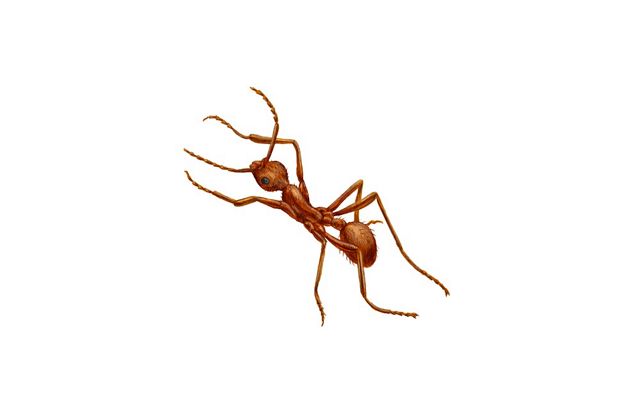
In August 2020 the American Ornithological Society reversed its decision on McCown’s longspur and renamed the bird the thick-billed longspur. In a subsequent online gathering, most ornithologists and bird lovers agreed that it was time for the Society to revisit at least some eponymous bird names—two of the nation’s top bird-guide authors, David Sibley and Kenn Kaufman, spoke in favor of reconsideration. But disagreement over how far to take the efforts is also evident.
James Van Remsen, a retired ornithology professor at Louisiana State University and a member of the American Ornithological Society committee that approves name changes, opposes eliminating all 145 or so honorific bird names as too cumbersome. Instead, he says, a dozen or so of the most egregious names should be changed.
Van Remsen says other birders agree but are afraid to speak up. “They like knowing something about the origin of the bird and its discovery,” he says. “Of all the things that we could do to make up for some of the brutality of that era, changing bird names seems to a lot of people to be way down the list.”
The diversity of views was apparent earlier this year when the National Audubon Society considered and then declined to rename itself. (Its namesake John James Audubon owned enslaved people.) In response to the decision to keep the name, three members of the organization’s board resigned.
As birds, fish, insects and places take on new names, the debate over how to handle history and cultural sensitivity isn’t slowing down: The Entomological Society’s Better Common Names Project now accepts public submissions. The American Ornithological Society has tasked a committee with developing recommendations for how to handle renaming birds. In the meantime, though, the Scott’s oriole remains as is. Stephen Carr Hampton has suggested a new and less-charged name in honor of its habitat: the yucca oriole.
Editor's Note:
The American Ornithological Society announced on November 1, 2023, that it plans to change the English common names of all American birds named after people as well as other names deemed offensive or exclusionary. The process will begin in 2024 and will focus initially on 70 to 80 birds found in the U.S. or Canada. New names are expected to describe characteristics of the birds themselves. In a statement announcing the decision, Society executive director and CEO Judith Scarl said, “As scientists, we work to eliminate bias in science. But there has been historic bias in how birds are named, and who might have a bird named in their honor. Exclusionary naming conventions developed in the 1800s, clouded by racism and misogyny, don’t work for us today, and the time has come for us to transform this process and redirect the focus to the birds, where it belongs.”
Magazine Stories in Your Inbox
Sign up for the Nature News email and receive conservation stories each month.
Please provide a valid email address
You’ve already signed up with this email address. To review your email preferences, please visit nature.org/emailpreferences
We may have detected a typo. Please enter a valid email address (formatted as [email protected]). Did you mean to type ?
We are sorry, but there was a problem processing the reCAPTCHA response. Please contact us at [email protected] or try again later.
About the Creators
Illustrator Zoe Keller was commissioned to create these illustrations for Nature Conservancy magazine. Based in Maine, Keller specializes in graphite drawings and digital media portraying the natural world. Writer Suzanne Goldsmith is based in Columbus, Ohio. She is the author of two books and is a former editor for Columbus Monthly .
Fall 2023 Issue

Ocean of Opportunity
Barbados has committed to protect up to 30% of its massive marine space, proving that a small island nation can generate a huge conservation win.

Winds of Change
A revolutionary wind farm in Kenya is transforming the way renewable energy, communities and wildlife coexist.
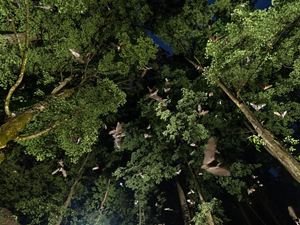
Up From The Underground
In Tennessee, protecting bats starts with restoring caves.
We personalize nature.org for you
This website uses cookies to enhance your experience and analyze performance and traffic on our website.
To manage or opt-out of receiving cookies, please visit our
Your browser is ancient! Upgrade to a different browser or install Google Chrome Frame to experience this site.

Search form
- History of Victoria’s grasslands
- The Western Grasslands Reserves
- Field guide
- Quadrats online
- Grassland Food Webs
- Managing Grasslands
- Talk with the Experts
- Mt Rothwell Virtual Tour
- Interactive Quiz
- teacher resources
- student resources
- latest news
- where to find
Wandering Jew

- Distribution
- Conservation Status
Tradescantia fluminensis
Perennial. This plant can spread quickly by forming roots at the leaf nodes when a stem comes into contact with the soil. The waxy cuticle on the leaf surface reduces the uptake of herbicides.
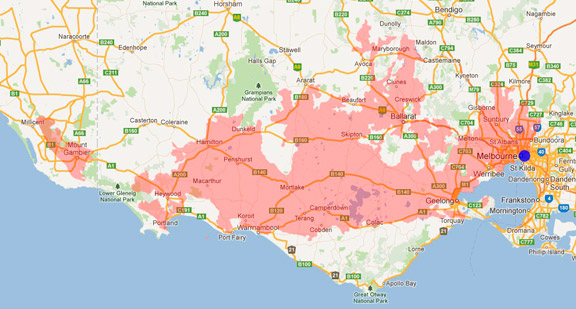
Distribution maps indicate current and historic locations where species have been sighted.
Source: Atlas of Living Australia
The conservation status of species is listed within Victoria and Australia.
The Department of Environment and Primary Industry (DEPI) Advisory List consists of non-statutory advisory lists of rare or threatened flora and fauna within Victoria.
The Flora and Fauna Guarantee Act 1988 (FFG Act) lists threatened species in Victoria. Under the Act, an Action Statement is produced for each listed species.
The Environment Protection and Biodiversity Conservation Act 1999 (EPBC Act) is the Australian Government’s key piece of environmental legislation, listing nationally threatened native species and ecological communities.
Submit a sighting
Quick Links
- Folding Frog Card
- Flora and Fauna Field Guide App
- Footprints of the Western Volcanic Plains
- Request new password
Interesting Fact
Dense growth of this invasive weed can occur. Although the root system is shallow and can be removed easily, the stems can resprout.
Latest News
Footer menu.
- Disclaimer and Privacy Statement


IMAGES
VIDEO
COMMENTS
Tradescantia zebrina, formerly known as Zebrina pendula, is a species of creeping plant in the Tradescantia genus. Common names include silver inch plant and wandering Jew. [1] The latter name is controversial, [2] and some now use the alternative wandering dude. [3] The plant is popular in cultivation due to its fast growth and attractive foliage.
An attractive, invasive pest, but an invasive pest nonetheless. Wandering Jew is a native of Mexico and Central America, including Belize, Honduras, Panama, Costa Rica and Guatamala. It's beauty, however, has taken it to nearly every corner of the globe as a house or garden plant. The problem is it invariably escapes cultivation and establishes ...
The common name wandering Jew refers both to the wandering habit of several species within Tradescantia, and also to a character from early Christian mythology. Description Flower close up. Tradescantia fluminensis is a perennial groundcover that spreads along the ground with soft, hairless stems and leaves. The fleshy stems root at any node ...
Tradescantia ( / ˌtrædəˈskæntiə / [4]) is a genus of 85 species [5] of herbaceous perennial wildflowers in the family Commelinaceae, native to the Americas from southern Canada to northern Argentina, including the West Indies. Members of the genus are known by many common names, including inchplant, wandering jew, spiderwort, [6 ...
Summary 2. Tradescantia zebrina, formerly known as Zebrina pendula, is a species of spiderwort more commonly known as an inchplant or wandering jew. The common name is shared with closely related varieties T. fluminensis and T. pallida. Tradescantia zebrina is native to Mexico, Central America and Colombia, and naturalized in parts of Asia ...
Many countries around the world view the wandering Jew as an invasive species. Therefore, you won't find many of them as regular additions to gardens. However, ... This wandering Jew species features white flowers, and it's a trendy indoor plant around the world. The species originates from the southeastern region of Brazil.
The wandering Jew plant is a common name for different species of plants that belong to the Tradescantia genus. There are around 75 different types of plants in Tradescantia genus and some are called inch plants, spiderwort, striped wandering Jew, Boat Lily, Purple Queen, or flowering inch plant. Wandering Jew plants are great house plants because they are relatively easy to care for.
Invasive. For Status Assessments: Invasive and not recommended by IFAS. Will be reassessed every 10 years. Specified and limited uses may be considered by the IFAS Invasive Plants Working Group. Assessment Status: Complete
Some of its 75 species are commonly called 'wandering jew' (also known as inch plant), a name they adapted due to their long lifespan like the Jewish character from a Christian folklore. ... in fact so well that it can be considered an invasive species. In countries like Australia, the plant has the capacity to invade natural vegetation ...
Common Name(s): Small-leaf spiderwort, wandering jew. Origin. ... Listed as a categroy I invasive species by Florida Exotic Pest Plant Council (FLEPPC). Description. Creeping, trailing, subsucculent perennial herb, much branched, with branch tips erect; often forming dense ground cover; prostrate stems rooting freely at nodes. Leaves parallel ...
Wandering Jew (Tradescantia zebrina) is a trailing evergreen perennial in its native habitat (USDA hardiness zones 9 through 12). Where it's not winter hardy, wandering Jew is grown year-round as a houseplant. Are wandering Jew plants toxic to cats and dogs? Wandering Jew is not considered outright toxic, but it can cause some skin irritation.
Summary 2 Tradescantia pallida is a species of spiderwort (a genus of New World plants) more commonly known as wandering jew, a name it shares with the closely related species T. fluminensis and T. zebrina.Other common names include purple secretia, purple heart and purple queen.It is native to the Gulf Coast region of eastern Mexico. Edward Palmer was the first European to observe and assign ...
Tradescantia zebrina (pronounced trad-es-KAN-tee-uh zeb-REE-nuh) is a species of creeping plant in the Tradescantia genus. Common names include wandering jude and inch plant. This plant was formerly called Zebrina pendula and wandering Jew. Another common name is Variegated Spiderwort.
All About Tradescantia. Known more widely as inch plant, spiderwort, or "wandering jew," Tradescantia are a genus of around seventy-five perennial flowering plants native to the regions between Canada and mid-South America. The genus became more well-known during the 1600s, during which foreign trade introduced the prior unknown beauties to ...
Among them: Wandering Jew (Tradescantia zebrina), Gypsy Braid (Senecio jacobsenii), Jew's Thorn (Euphorbia tirucalli), Lady of the Night (Cestrum nocturnum). Inside the rotunda gallery, other shrubs and greenery, each with names similarly referencing specific groups of people, grow inside tanks installed on a central circle of metal shelving ...
Common Name: Wandering Jew. Species Name: Tradescantia zebrina. ... A Wandering Jew plant growing in a pot. Plant Facts ; Origin: Mexico: Sun Preference: Partial: Susceptibility: Pinch regularly to keep plant bushy and branchin; spider mites . ID Characteristics. Leaf and Stem Characteristics. Plant Height: 10-foot diameter, 1-foot height;
A list was made of all native plants, and invasive (or potentially invasive) adventive plants. The special problems of controlling wandering Jew (Tradescantia fluminensis) were discussed with the landowner. This paper is a revision of that sent to the Queen Elizabeth 11National Trust in July 1989. Changes to the earlier script mostly involve ...
And in still others, where an animal or plant is an invasive species conservationists want eradicated, some fear names that reference foreign countries or ethnic groups could promote xenophobia. ... Silver inch plant There are several names for this common house plant, including the "wandering Jew."
Wandering jew, Zebrina pendula, is a totally different species, although it looks somewhat similar to Purple heart. It would be difficult to find a more colorful or faster-growing groundcover than wandering Jew. The purple-green leaves with broad, silvery stripes and purple undersides are produced along the succulent stems, which root wherever ...
It is also known by other names including the Wandering Jew, Flowering Inch Plant, Wandering Willie, Wandering Gypsy, Purple Queen, Spiderwort, and Tradescantia. What's more, Tradescantia is a genus of 75 species of wildflowers. The name comes from John Tradescant, a botanist who lived during the 17th century.
Effects of rate of application of triclopyr on wandering jew ( Tradescantia fluminensis Vell.) At about 1 year after application of the herbicide, the wandering Jew had regrown to about 3-50% cover, depending on the rate of triclopyr applied, and some indigenous seedlings had begun to appear, however, the survival of these seedlings was minimal.
The conservation status of species is listed within Victoria and Australia. The Department of Environment and Primary Industry (DEPI) Advisory List consists of non-statutory advisory lists of rare or threatened flora and fauna within Victoria.. The Flora and Fauna Guarantee Act 1988 (FFG Act) lists threatened species in Victoria. Under the Act, an Action Statement is produced for each listed ...
"For the wandering Jew plant, the name reflects the fact that it's invasive. The perception is that Jews come into an area, they take over, and transform the area in a way that people living ...